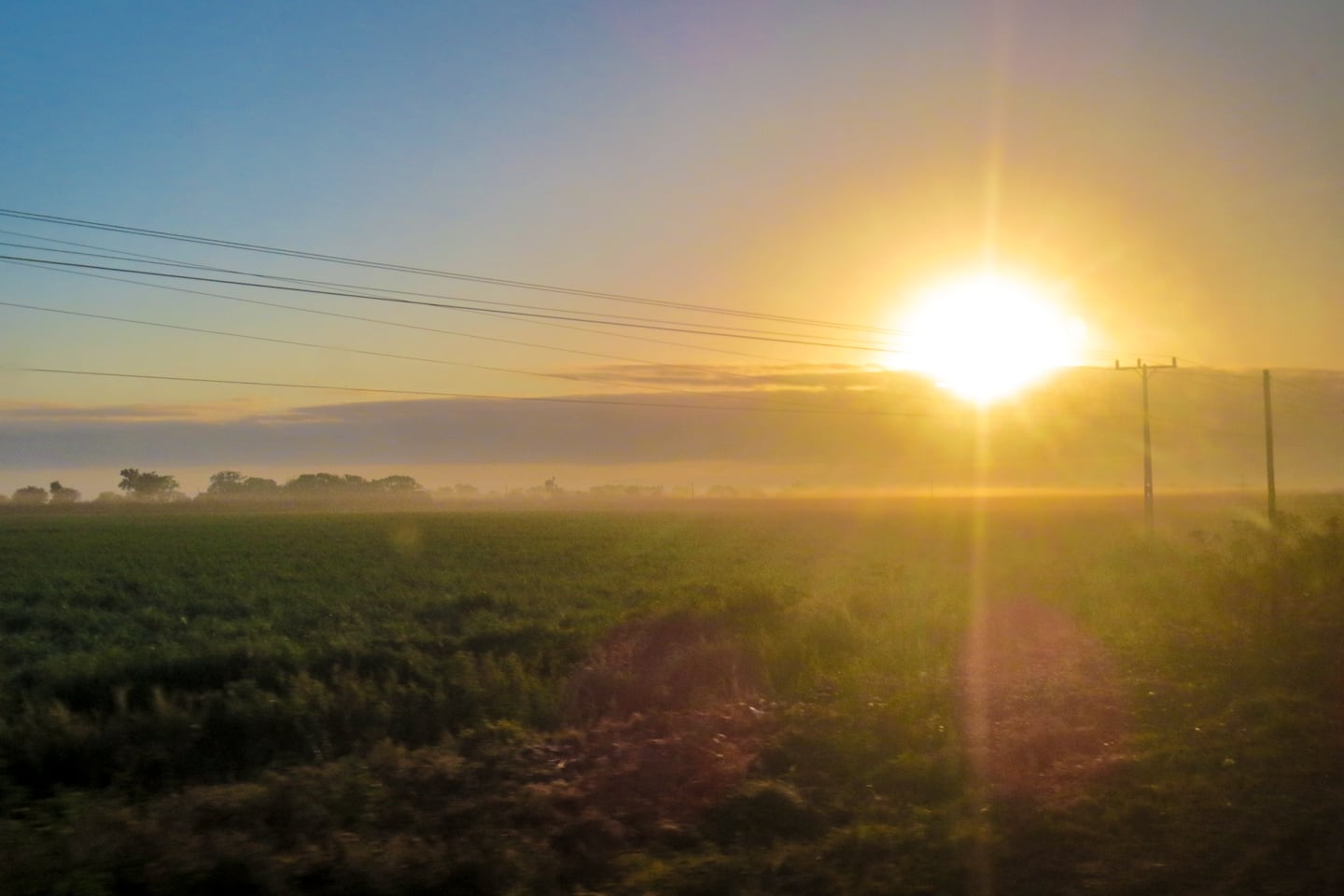
The Post Bus
Above and below, pretty pictures of a misty early morning in transit from Maputo to Maxixe. Interesting, sure, but even more interesting: I took these through the tinted window of my air-conditioned bus flying by at 120 kph.
Eight years ago, this simply wouldn’t have been possible. Sure, the Pantera Azul occasionally plied this route from South Africa, but nobody that I knew had ever actually ridden the Pantera up the EN-1. For most, the journey from Maputo to Maxixe involved a trip to the Junta (sprawling bus park outside of the capital), and a very long day on a variety of possible vehicles: chapas (minivan taxis), Chinese chapas (minibuses), goat buses, flatbed trucks, pickups, and so on. If you got up earlier enough, you could often catch an “express” bus, which generally resembled a 20-year-old discarded Greyhound bus that had been not-so-lovingly Mozambicafied, so to speak. The most reliable among these was the Oliveiras bus — Frankenbuses of sorts that had a penchant for anything but graceful aging. Despite their rough-and-tumble interior and exterior, they nearly always got you to where you needed to go, and were the safest bet in Southern Moz.
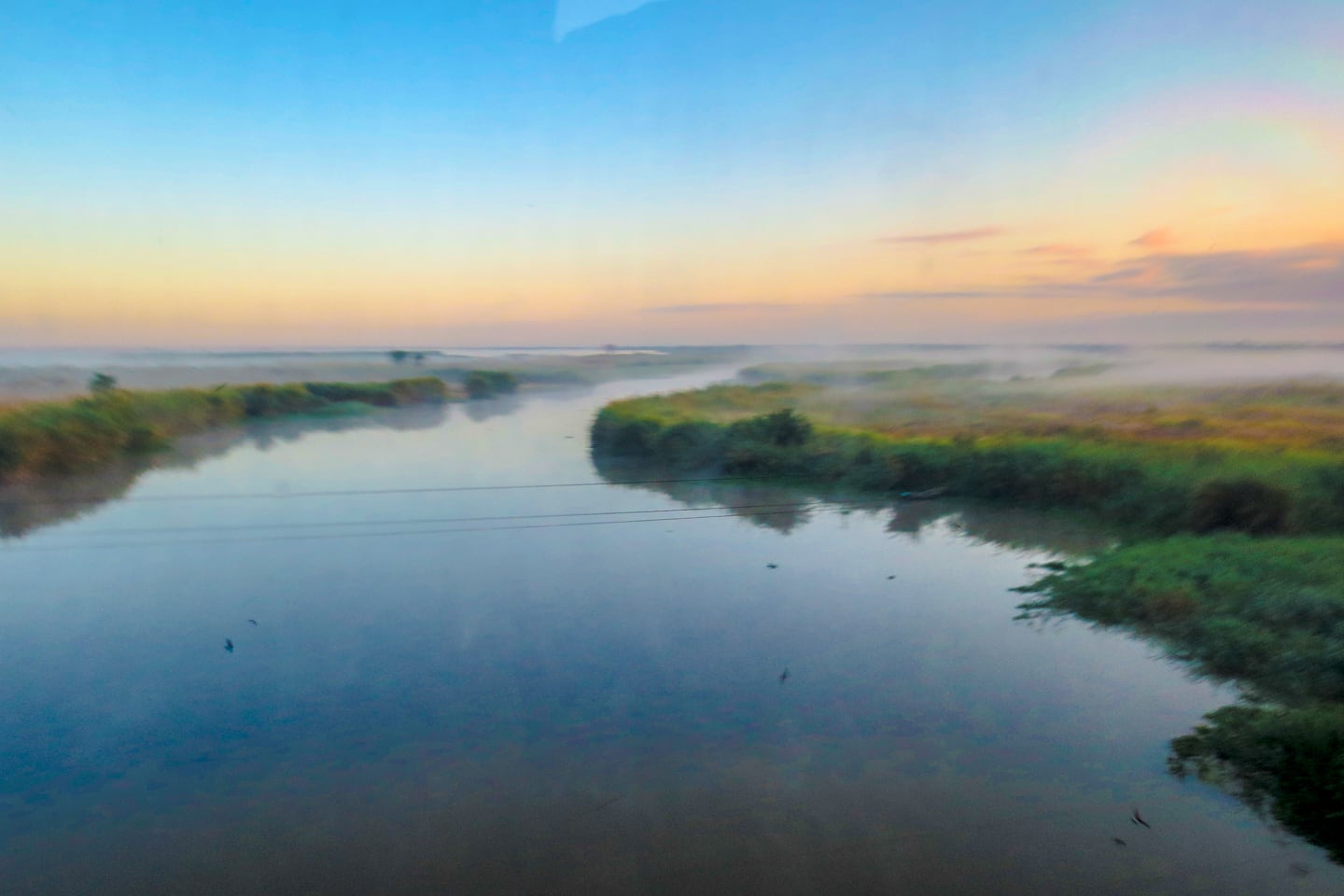
Yet, a ride on these large coaches certainly did not offer functioning reclining seats, tinted windows or curtains — though air came standard, provided that your seat had a functioning window and the bus was actually moving.
Today, Mozambicans have got some choices approaching something along the lines of luxury: Nagi (pictured above), Maning Nice, the now-defunct TCO (a reincarnation of the defunct Oliveiras), and inaugurated only days before our trip, The Mozambique Post Bus.
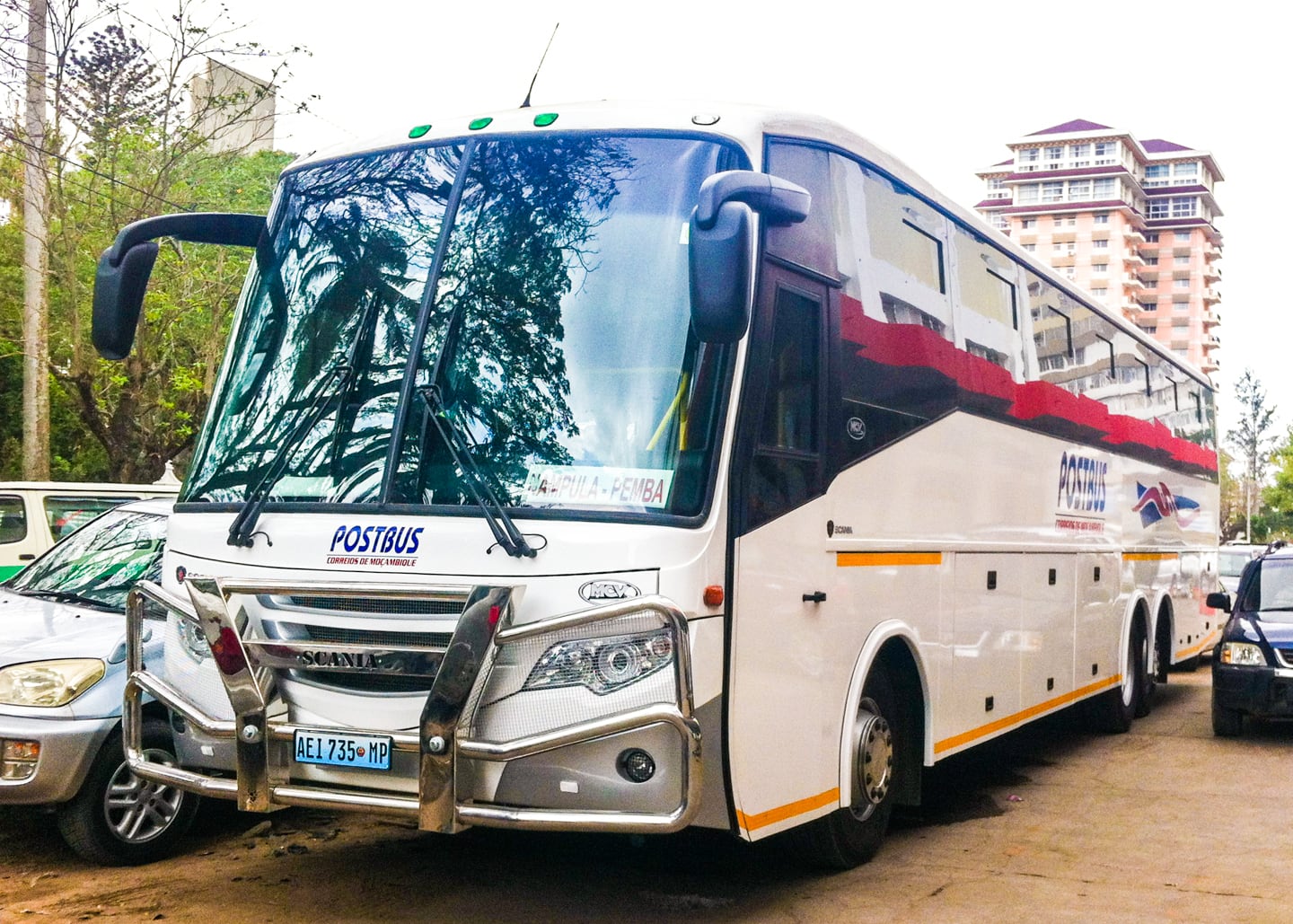
These pictures were taken at the Post Bus ticket office and terminal in Maputo a few days before our departure, as it would have been pitch dark at 3:55am when our Beira-bound bus pulled out of the station.
The service is still in its infancy. You won’t find any information yet online about Post Bus (save for a few short news articles), and most Post Offices aren’t yet equipped to give you any sort of reliable information. The service only runs on certain days of the week. Catching the Beira- or Tete-bound bus out of Maputo is straightforward enough, though — just go down to the office in the Baixa (behind the central Post Office, one street north of Av. 25 de Setembro, during regular business hours and ask when the bus is running. The agent we spoke to at the ticket office was very friendly and even spoke some English. You can buy the tickets before departure, but seats weren’t being assigned at the time, so we were advised to arrive around 3:20am on the day of departure. We were glad we did, because, despite the bus being half empty, all ticketed passengers had arrived and the bus actually left ahead of schedule.
If you are departing from anywhere else besides Maputo, it gets a bit more complicated, as there is no set schedule at this time. Buses are scheduled to leave Maputo, Beira, Tete, Quilemane, Nampula and Pemba at 3:55am, but the days of the week are still being worked out. They can apparently collect you in any major town along their routes (i.e. district capital with post office), but it has to be worked out ahead of time (meaning that you have to basically call the driver of that particular bus doing that particular route to see what the deal is and let him know). It’s still not clear to us whether tickets can be bought on the bus or only at post offices (and not all post offices are yet equipped to issue tickets). I suspect that in a few months, much of this will get ironed out, but in the meantime, this is the scoop.
For more information, you can contact the Post Bus office in Maputo at (country code 258) 843123102. I won’t post the drivers’ numbers here, as those are their actual private cell numbers, but the agents at the Maputo office will likely be happy to provide you with them if needed.
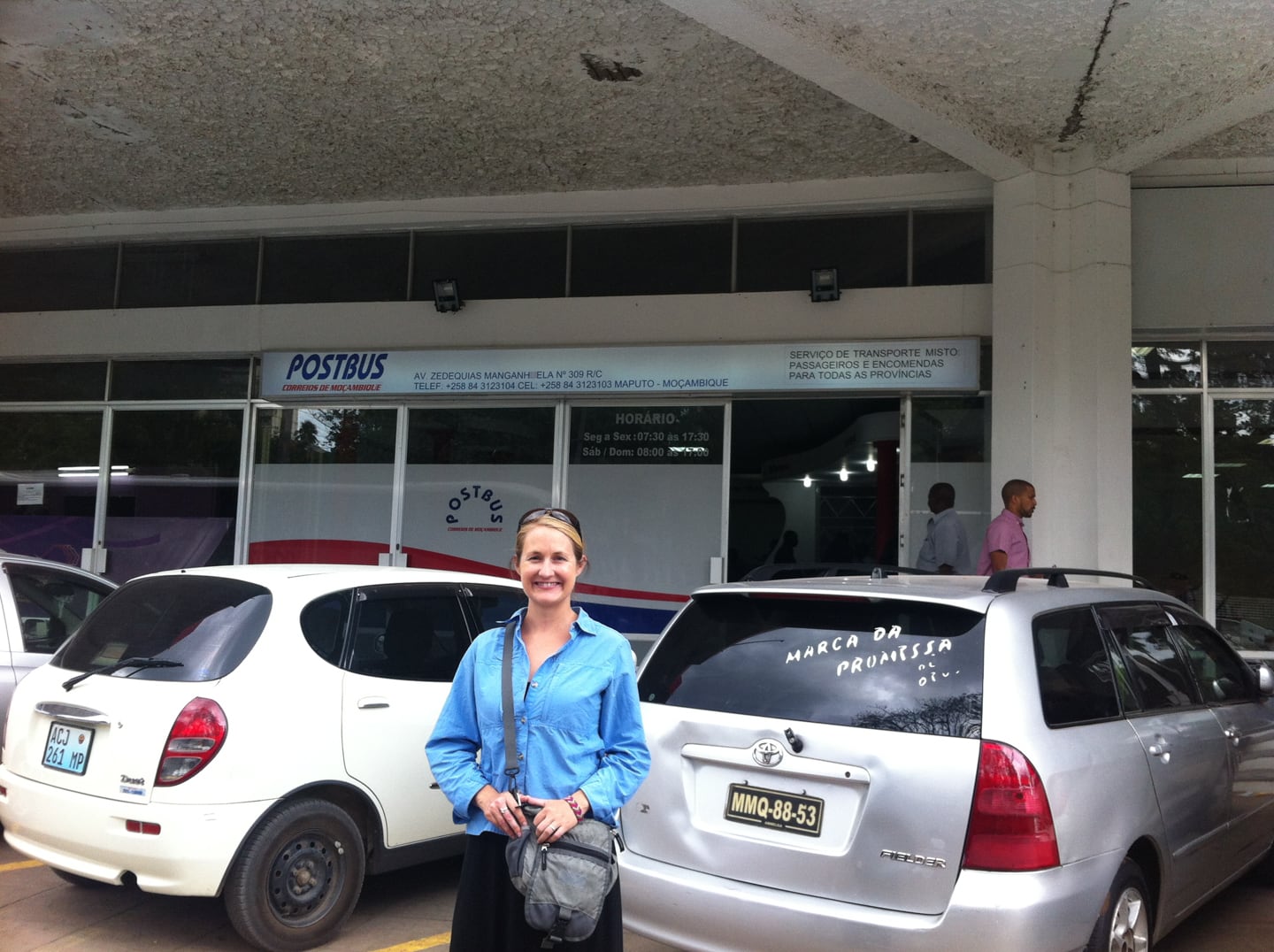
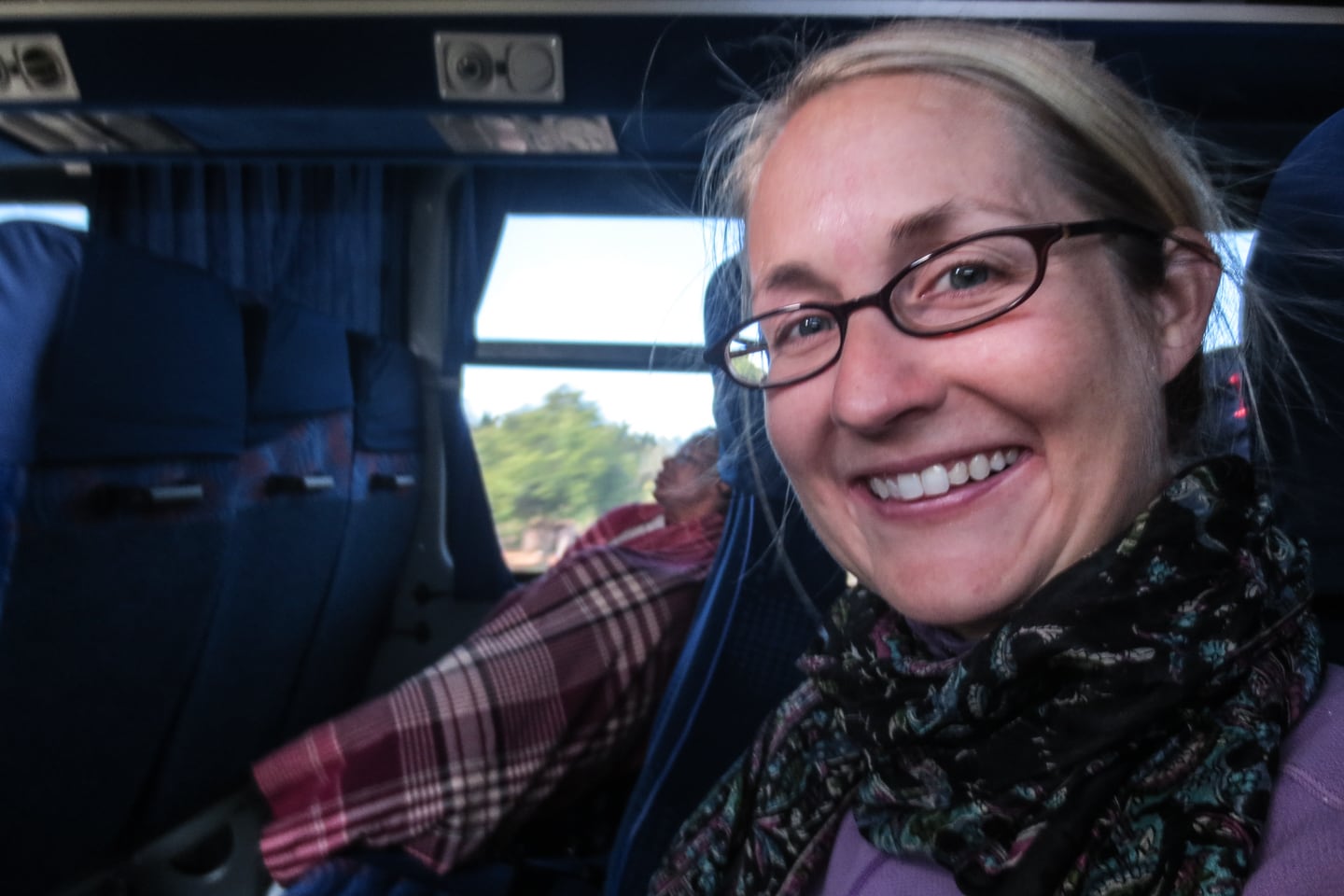
The Post Bus service is big news and a huge step forward for a country with twice the land area of California and, up until about ten years ago, no discernible national infrastructure. And by national infrastructure, I don’t just mean expressways, railways and maritime transit — I’m talking about electricity, running water, landfills and waste collection, telecommunications, sewage treatment, bridges and even two-lane highways connecting cities of tens or hundreds of thousands of residents.
On the other hand, the Post Bus also seems like a tiny step forward. It can sometimes be quite easy to fixate on the fact that in eight years, while economies in Asia have exploded, and China is building bullet train track faster than you can say Mao Tse Tung, Mozambique’s big public transit coup seems to have been convincing a few key investors to back an initiative that nearly every other industrialized African nation implemented in some form a half a century ago.

Welcome [back] to Mozambique.
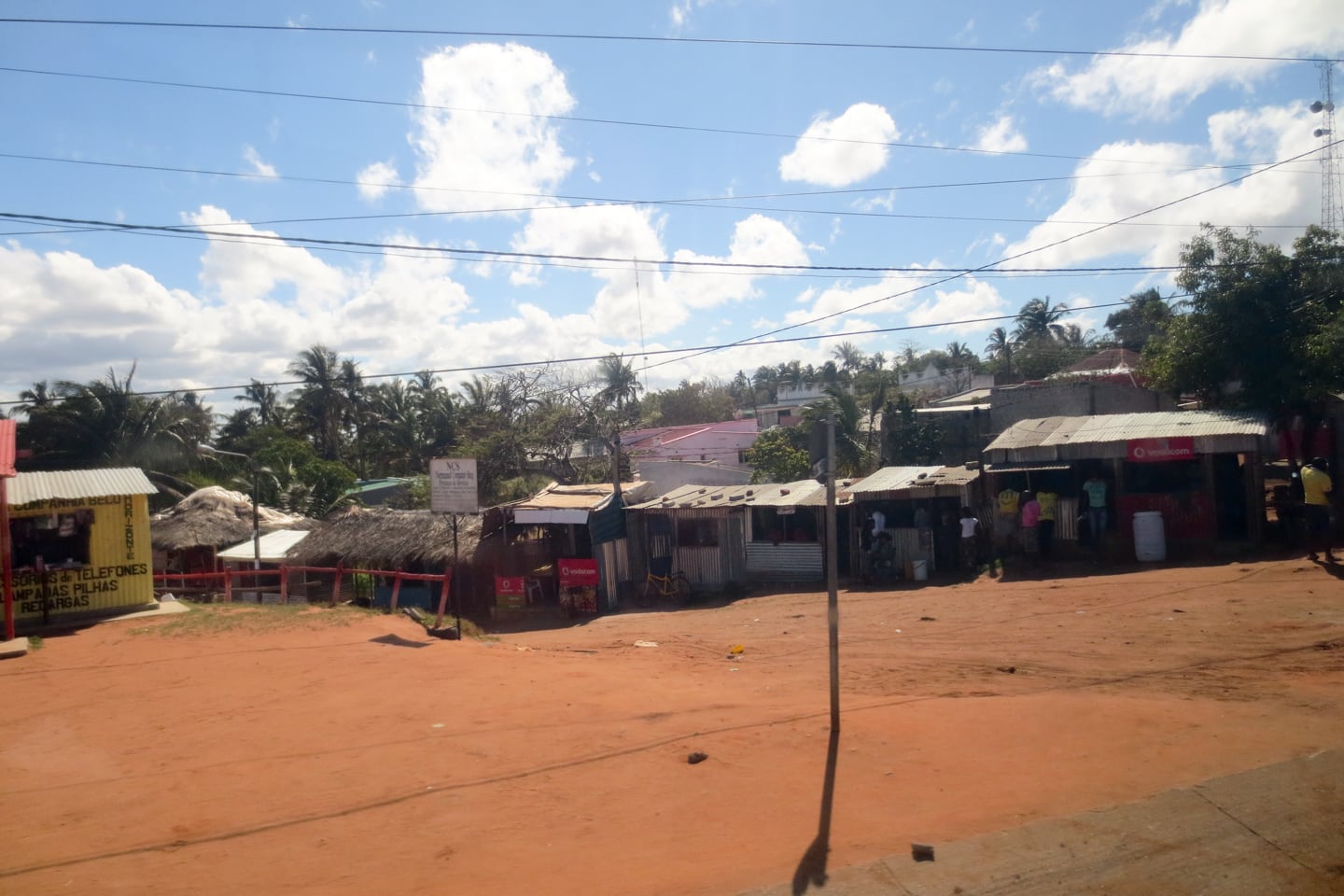
Regardless of whether the Post Bus is a big or small step, it is a step in the right direction. And, despite the 3am wake-up, it was an exceptionally comfortable ride by any standard. Maputo to Maxixe, 500km (300 miles) in 6 hours going the speed limit with two 5-minute bathroom breaks. Heavenly.
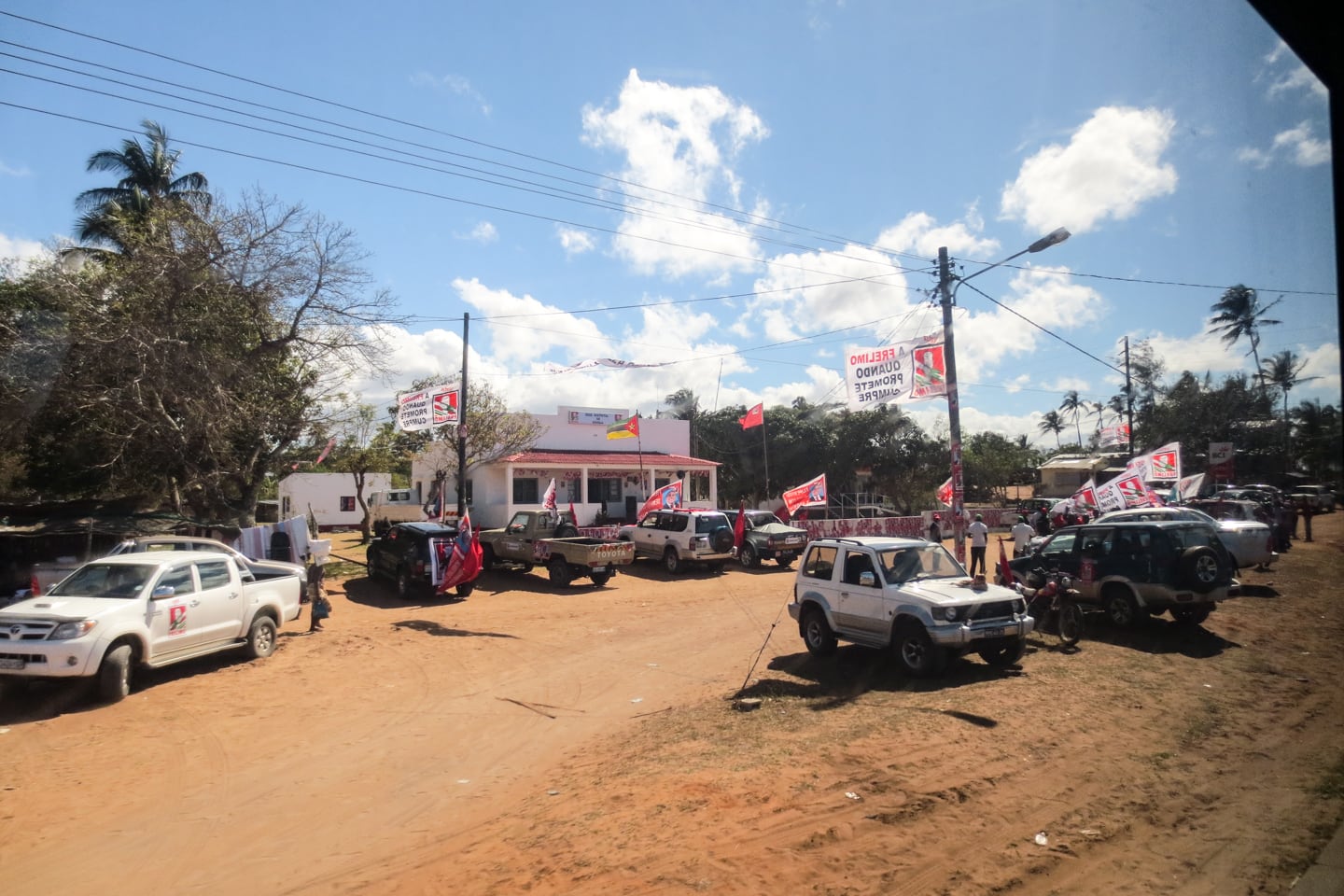
It’s general elections this month in Mozambique! And signs are literally everywhere — on shops, houses, cars, light posts — mostly advertising the current ruling party, FRELIMO, which isn’t a big surprise. Best thing about the campaigning materials (which either feature the presidential candidate’s mug or a distinct coat-of-arms of sorts for the nation’s significant number of illiterate electorate (and undoubtedly, branding purposes) is that the branding seemed to work like gangbusters on Lori. She could never remember the names of the three main political parties, but could always remember their logo. Lori: “Who’s ahead, the rooster or the corn and drum?” The corn and drum, honey. The corn and drum.
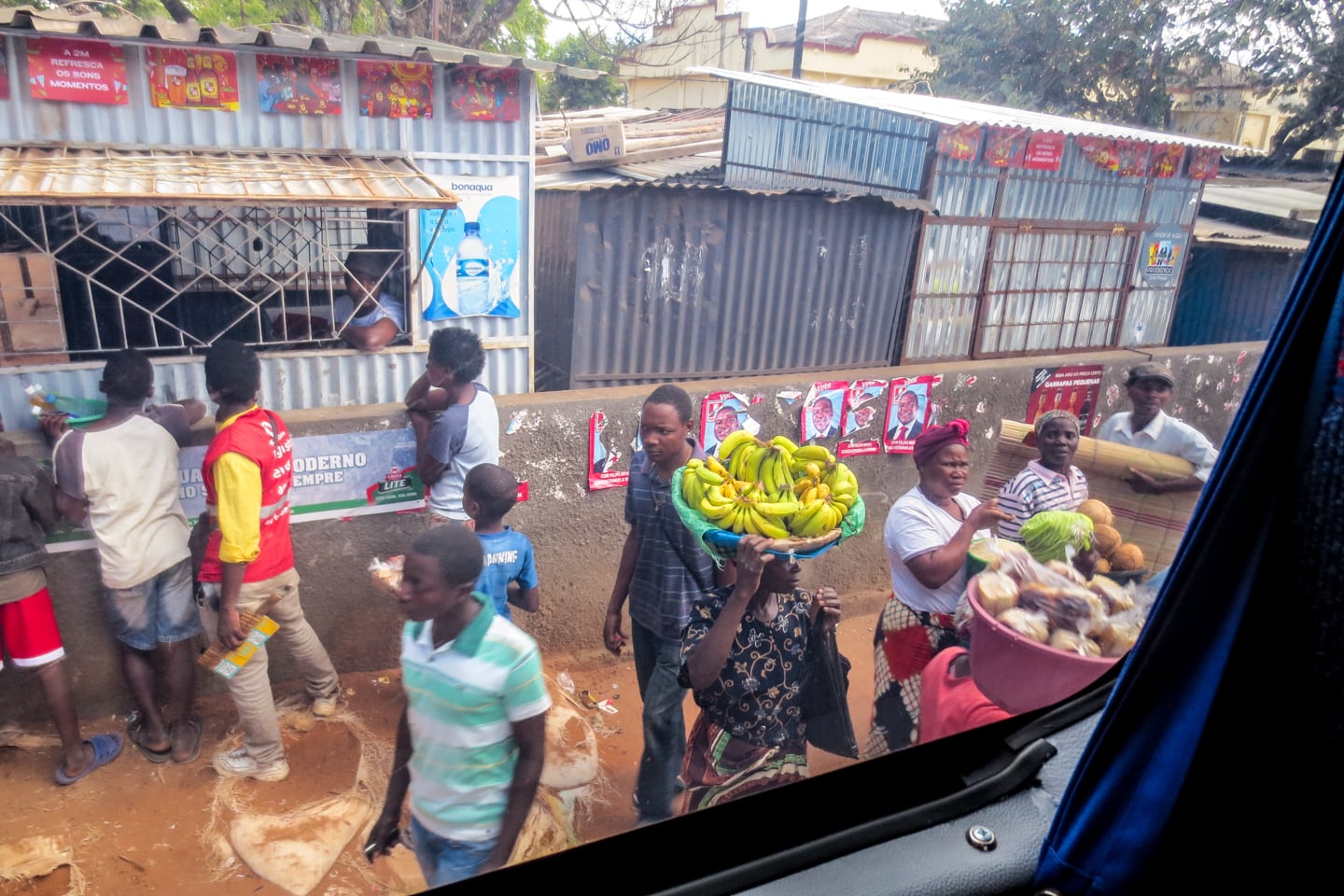
If riding the Post Bus had a disadvantage, it most certainly was the limited access to street vendors. In the past, I always enjoyed having ready access to fruit, bread, crackers, soda, the occasional set of bow-and-arrows, but the Post Bus’s modern design and air-conditioned interior made all of this virtually impossible to access without getting off the bus. Honestly, it was a bit cruel. I really wanted bananas — and there they were — BANANAS! Undoubtedly, the woman wanted to make a sale. Nobody was buying. I was salivating. Our eyes were locked, but we both knew the score. The bus was rolling out…and…bye bye bananas. They were good looking bananas, too.
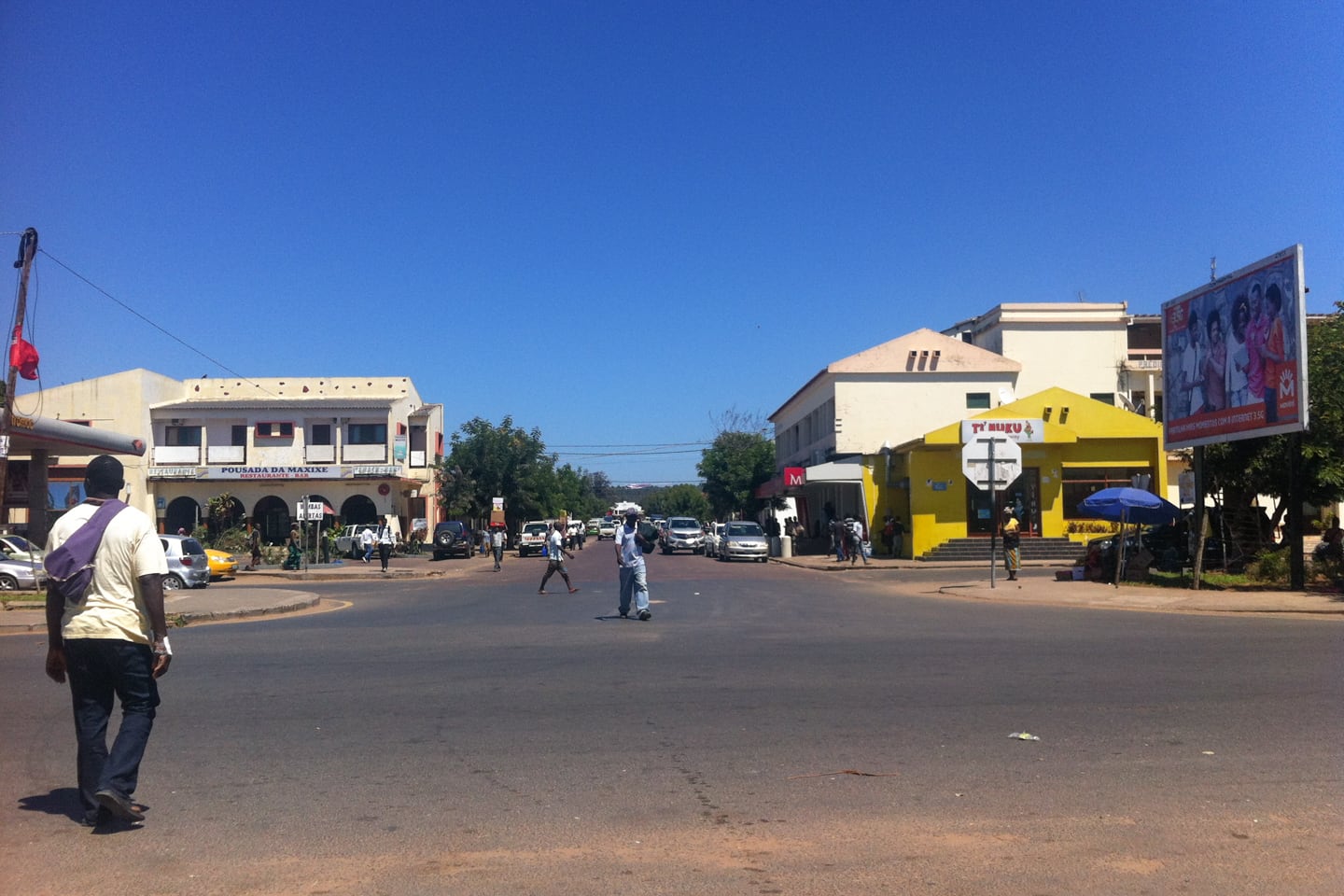
Changes
Our bus rolled into Maxixe a little after 10am and my jaw dropped. Where were we? This was not the Maxixe I remember. In eight years it had gone from a sandy, crumbly transit hub with one paved road (the southbound lane of the national highway) to a paved, tree-lined — almost pleasant — bayside city, with shiny new petrol stations, strip malls, take-away restaurants and a pleasant little central park. I use to return to my town at the end of the day with shoes filled with sand from running errands in Maxixe. In those days, the city was something resembling a mix of rundown Latin American beach town and American Wild West frontier town. Huge mountains of trash regularly piled up in the center of major boulevards. Buildings appeared like they hadn’t received a fresh coat of paint or spackle since the 1960s (and in many cases, this was true). Sickly, stray dogs terrorized the streets at all hours. Every alcove of every building reeked of an unholy mixture of urine, vomit, rotting fruit and dog poo. But this was a new Maxixe.
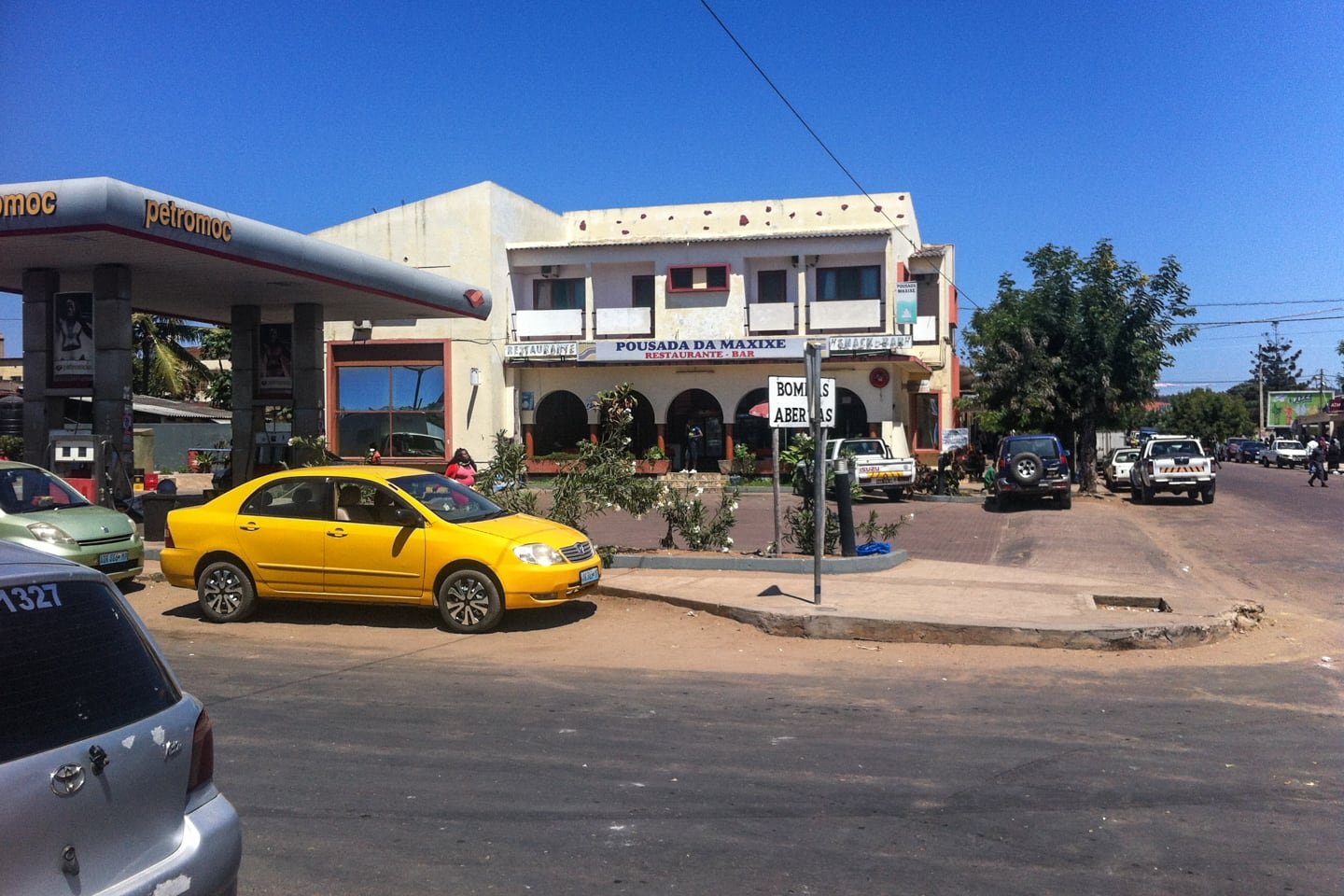
Yet, all the old favorites were there: the Stop and Pousada restaurants, the central market and far market (though fairly scaled-down versions of their former selves)…
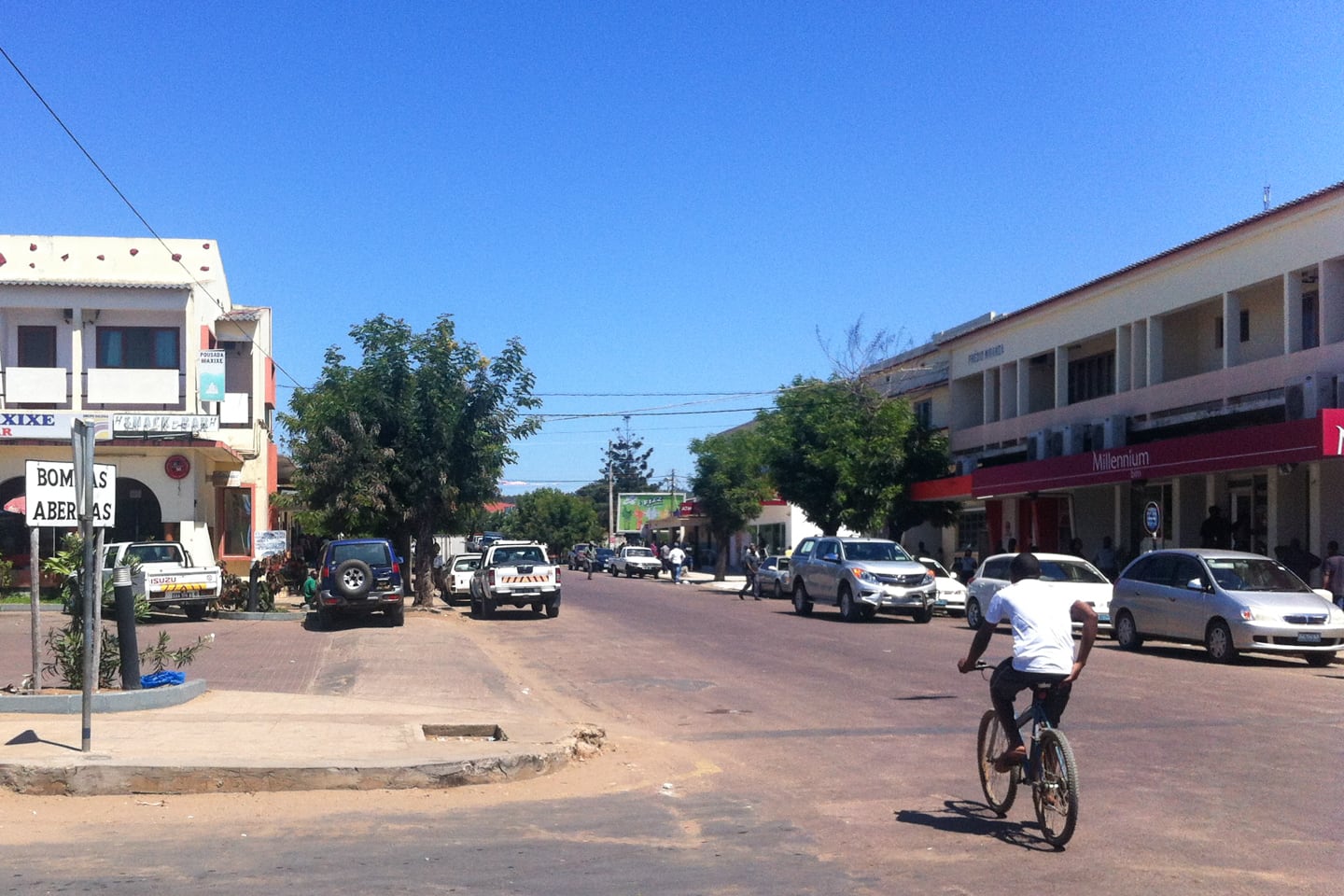
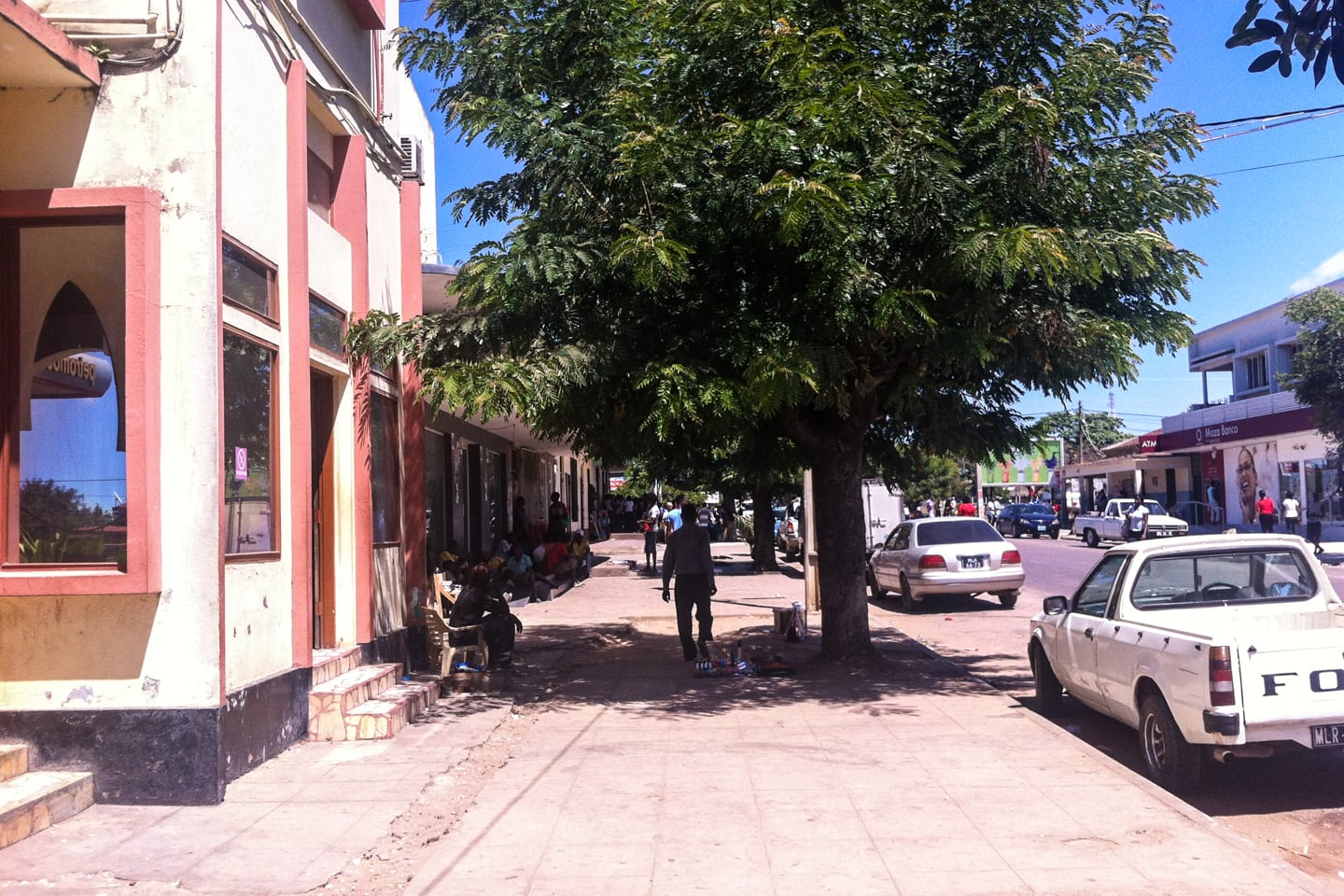
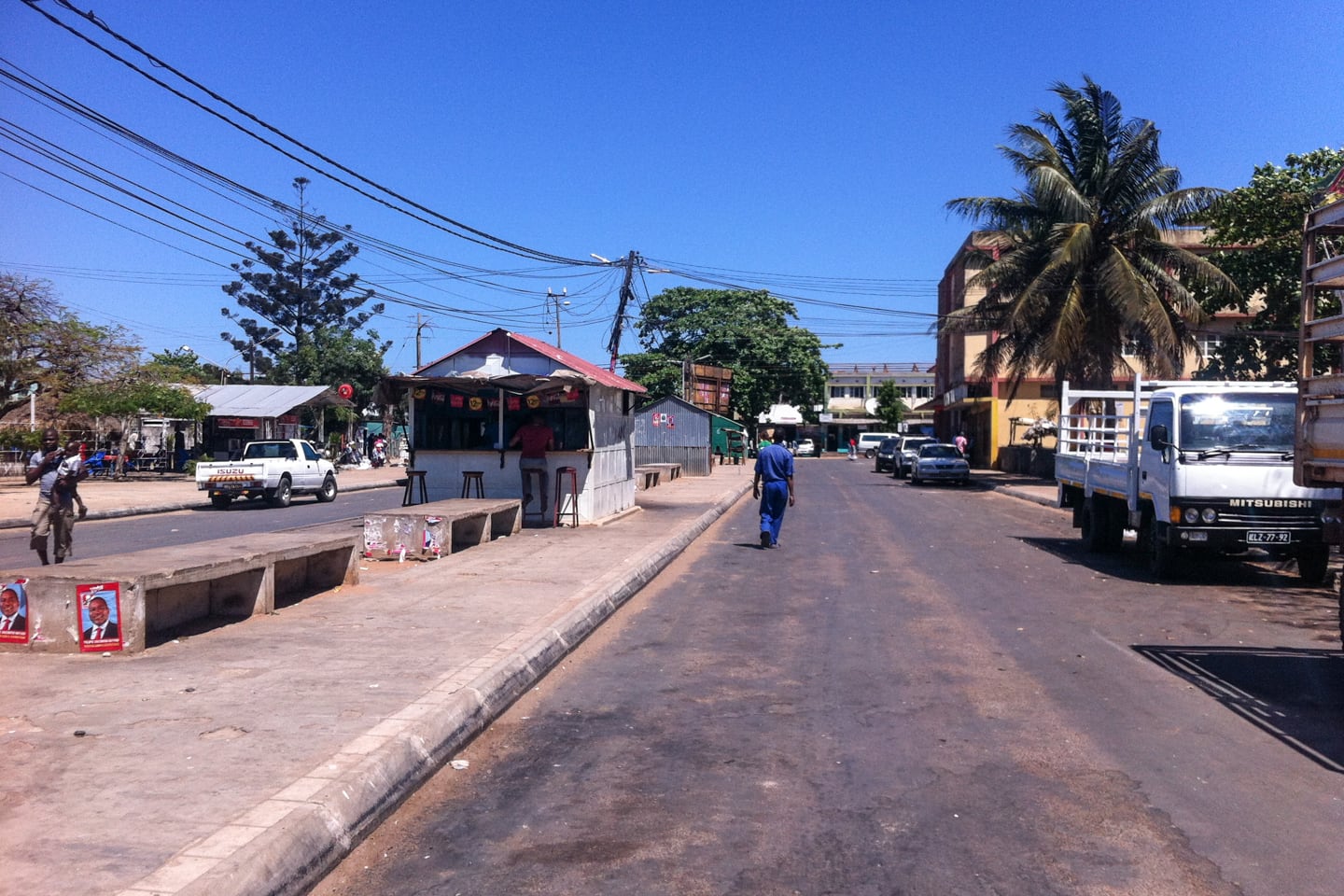
…the Chinese Fotomat and snack shack where I used to get egg and cheese sandwiches (but no sign of the sandwiches, unfortunately)…
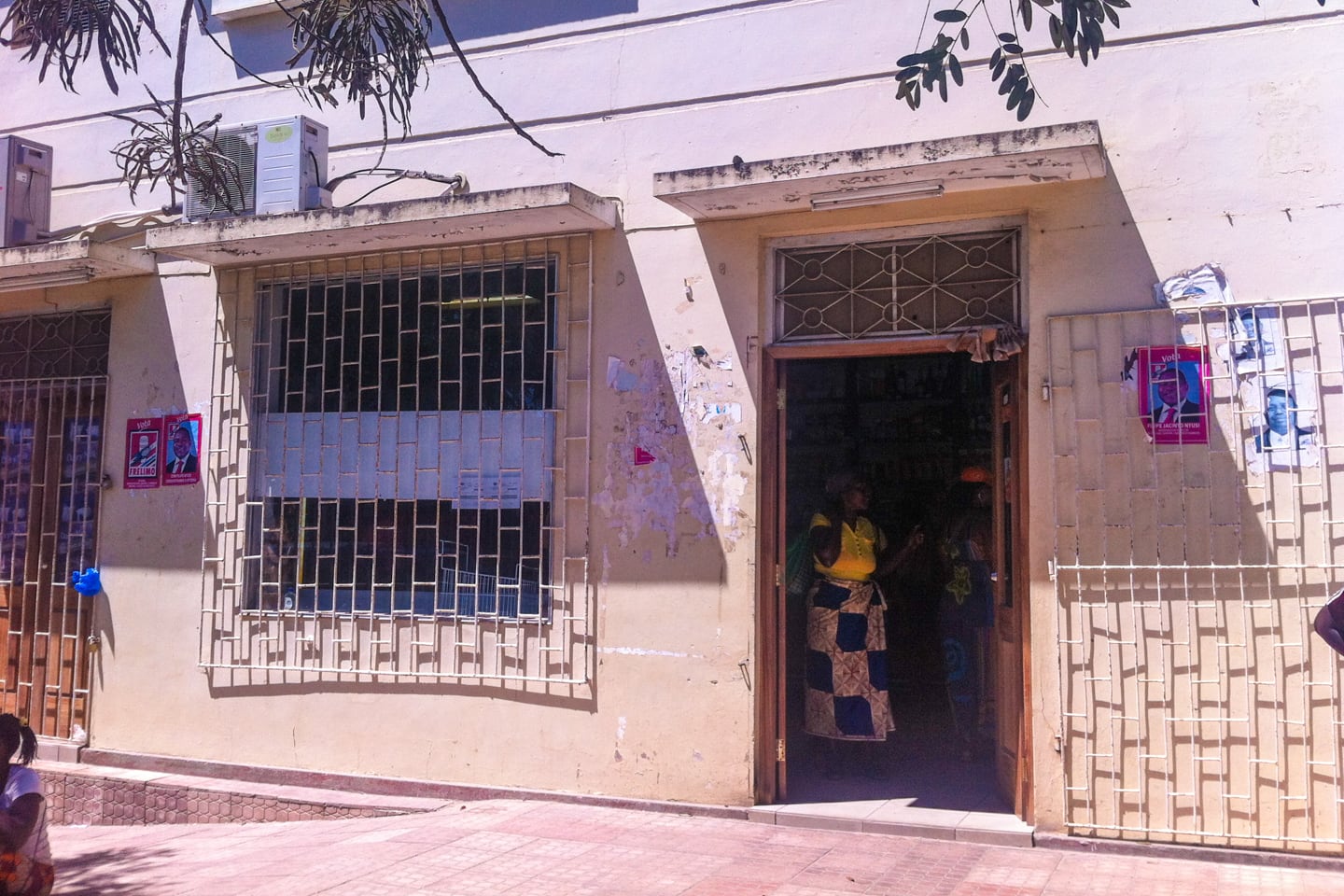
…the “South African” (i.e. Taurus) supermarket, now catering primarily to Mozambicans rather than the few expats in the area…
And, the legendary “Magic Loja,” affectionately named by Peace Corps volunteers of the time (above). It was unmarked, a bit tricky to find, and the only place in early 2005 to buy CHEDDAR CHEESE in Inhambane Province. A trip to the Magic Loja made for a very happy day indeed.
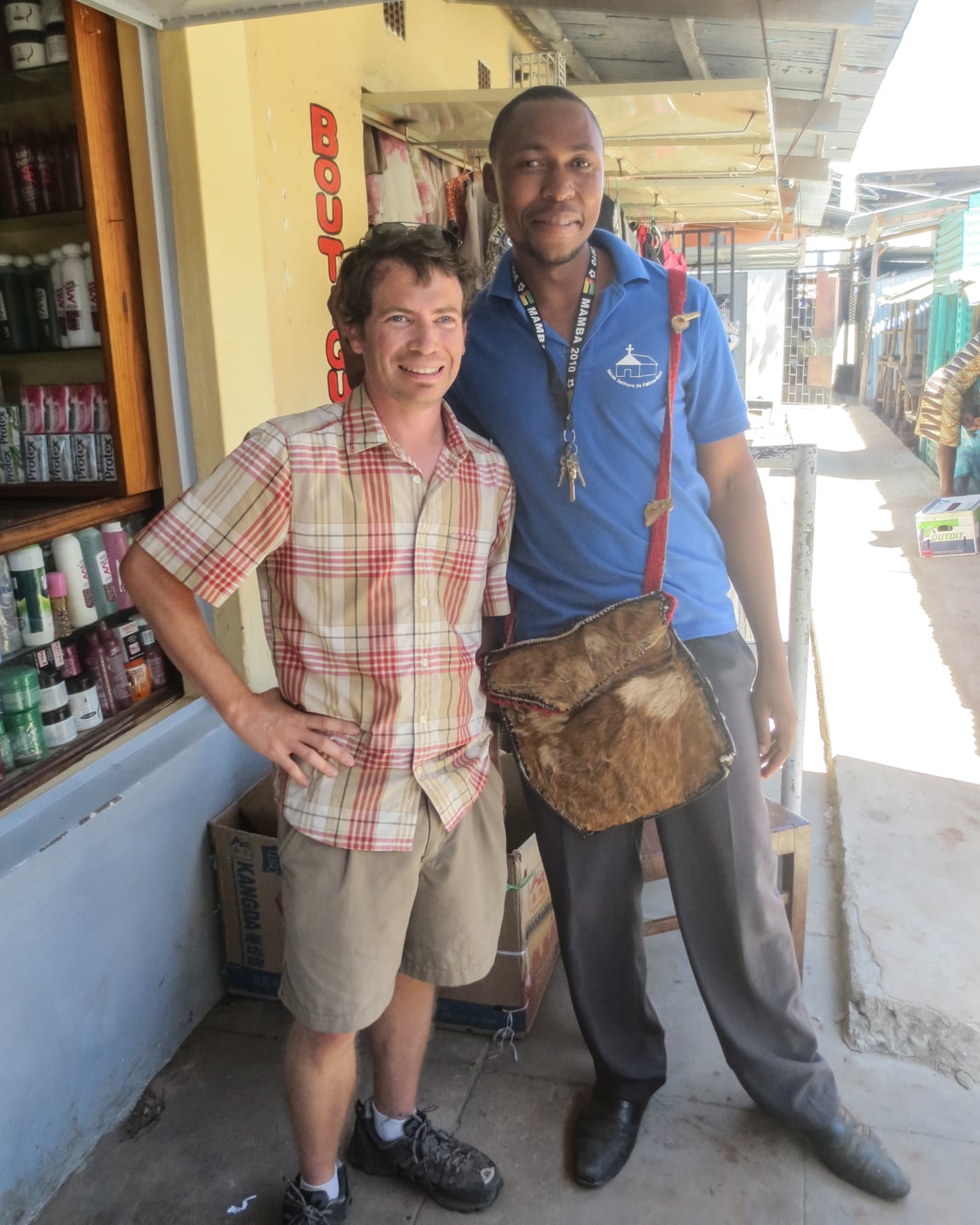
We even ran into one of my old students in the market. I remembered him but didn’t remember his name at first (I had over 400 students a year…). But when I saw him, I remembered he was one of my better students, one that asked questions and occasionally attended tutoring sessions, and I was happy to hear him speaking in English and that it was quite good. He was working in the Maxixe market now, along with several other former students of mine (according to him, but I didn’t run into any others there).
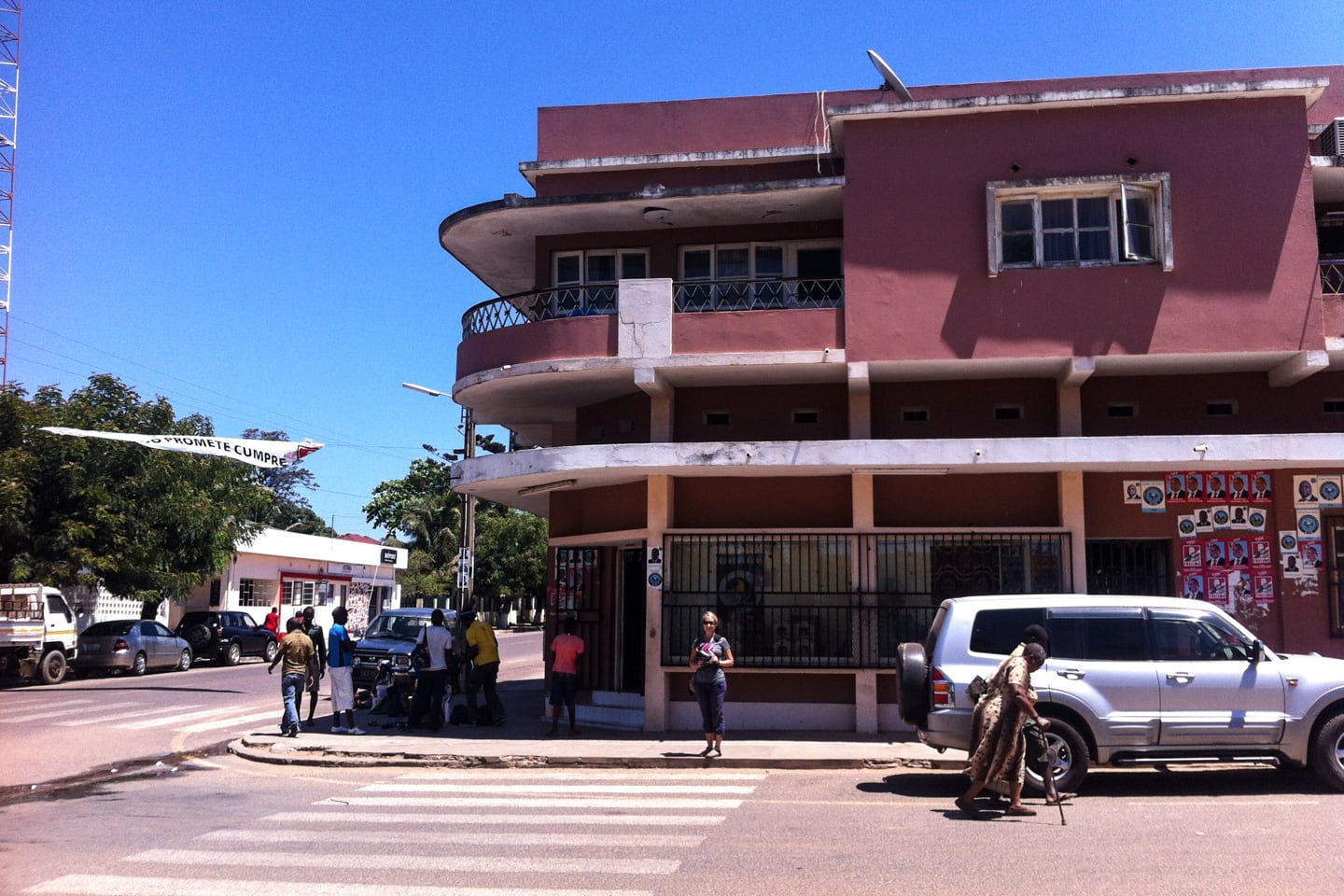
Lori wanted to get a capulana (sarong), what most women wear around their waists in Mozambique. We poked in to a few shops in Maputo and didn’t see anything interesting. I told her to wait til we get to Maxixe, hoping that my old capulana connection was still kicking, and sure enough it was! The place (pictured above) is the best place anywhere to get a Mozambican capulana. The Indian-run shop was just how I remember, packed from floor to ceiling with the colorful imported material. I used to get all of my capulanas there (which I used for anything from table-cloths to room dividers or material for shirts), and this is the shop I took my parents and sister to to stock up when they visited nine years ago.
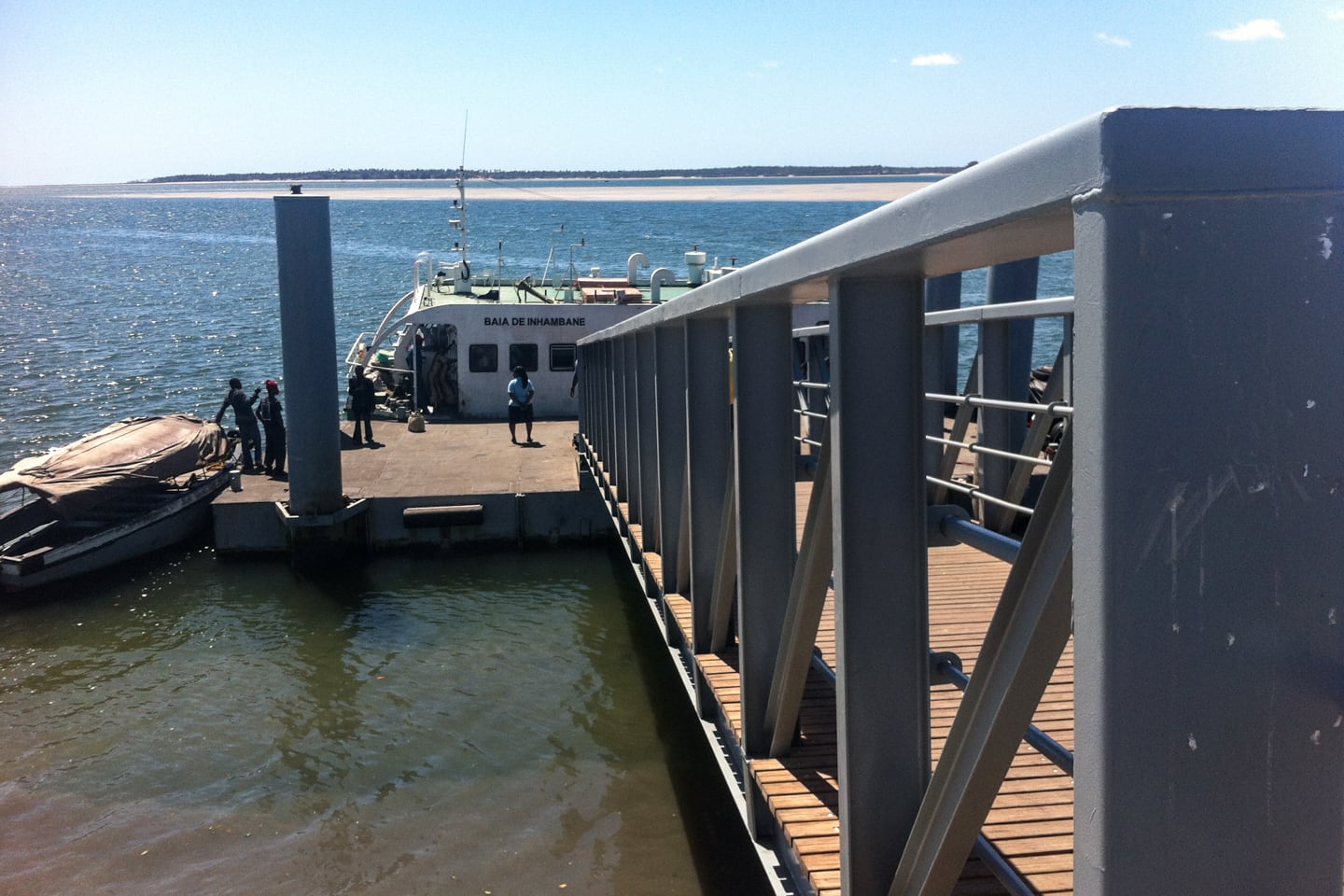
Room for Doubt
So that’s Maxixe 2014. It would be great to compare photos side-by-side if I had my pictures from 2004-06 with me, but that’ll have to wait until December.
A shinier Maxixe. But is it a happier Maxixe? Hard to say. One thing I can say for certain is that I did not feel as at ease this time around as I did a decade ago, but that could be due to a number of factors. The city, while tidier, felt a less welcoming. People seemed to have more of an edge than before. In the 50 or so times I had visited Maxixe as a Peace Corps volunteer, I was never given a reason to be concerned about my security. Sure, the dhow touts walking to the ferry could be very persistent, some gas attendants once tried to drastically overcharge me and my family for gas at a petrol station, and one of the PCVs who lived here had his reed house broken into over the holidays (as I did), but I had never been roughed up in any way…until our visit.
We had just left the market where moments earlier I had run into one of my students. As we were walking around a corner a young man went out of his way to run into me, then grabbed my arm and started saying something to me which I didn’t understand.
When walking around places Lori and I are not familiar with, we generally have our guard up and are fairly skeptical of the motives of strangers we encounter on the street. We wish it didn’t have to be this way, but it does, unfortunately. There are all sorts of cons and tricks people the world over have devised to relieve foreigners of the contents of their pockets and other valuables. Besides a camera that was picked from Lori’s purse in Nicaragua many years ago, we’ve been fortunate in this respect — though people have tried to con us many, many times. One classic pick-pocketing trick is that an individual runs into somebody hard, or steps on their toes, etc., and profusely apologies — all the while their accomplice(s) take advantage of the situation, grabbing the individual’s wallet, phone, keys, whatever they might have easily accessible.
This is what was happening here, and I wouldn’t have typically left myself so open to this well-known scheme if I hadn’t been on the lookout for any of my students I recognized. I gave the guy the benefit of the doubt (even when he grabbed my arm, as it’s not uncommon for Mozambicans to do this as a friendly gesture if they’re acquainted with you). Moments later, however, two other young men came around and reached for my pockets — in that instant, I pushed the first guy away and angrily screamed at the others. Perhaps not the smartest reaction, but knee-jerk and in the end very effective. Lori was walking ahead of me and ran back when she heard me. By then, the guys were scurrying away.
I was fine, nothing had been taken and there was nothing else to do, certainly not in Mozambique. Strangely, I wasn’t shaken up so much as furious at the kids. The incident changed my perspective in an instant on a place I had once felt so comfortable in. It also made me sad. This stuff happened in South Africa and Maputo, but it wasn’t something that happened in Maxixe. Not in broad daylight. Not to someone who was dressed appropriately and not waving around a guidebook, camera or backpack. I was dressed just as I had been, carried myself in the same way, spoke the language and knew my way around.
The 30-second incident cast a shadow over the day and forced me to contemplate the trajectory of Mozambique. Development is all around, tangible material improvements, you can see and feel them. But are things better? Are people happier, more satisfied, more fulfilled? The three young men who accosted me were clean-cut and dressed nicely, much more so than most folks I used to encounter in Maxixe ten years ago. This act wasn’t just a product of poverty or desperation, no, this was something else entirely. Anger, frustration, greed, lack of respect, or self-respect, driven by a ‘take what’s mine’ from the foreign white people attitude. It’s all around you in South Africa, but I hadn’t previously experienced it in towns across Moz, not in this way. It’s one isolated incident…but there is a sharper edge here, particularly among Mozambique’s youth. There’s a confidence I hadn’t seen before, but also a nihilistic (apathetic, destructive, disrespectful…) attitude that is disheartening. We’ll see what the next decade brings.
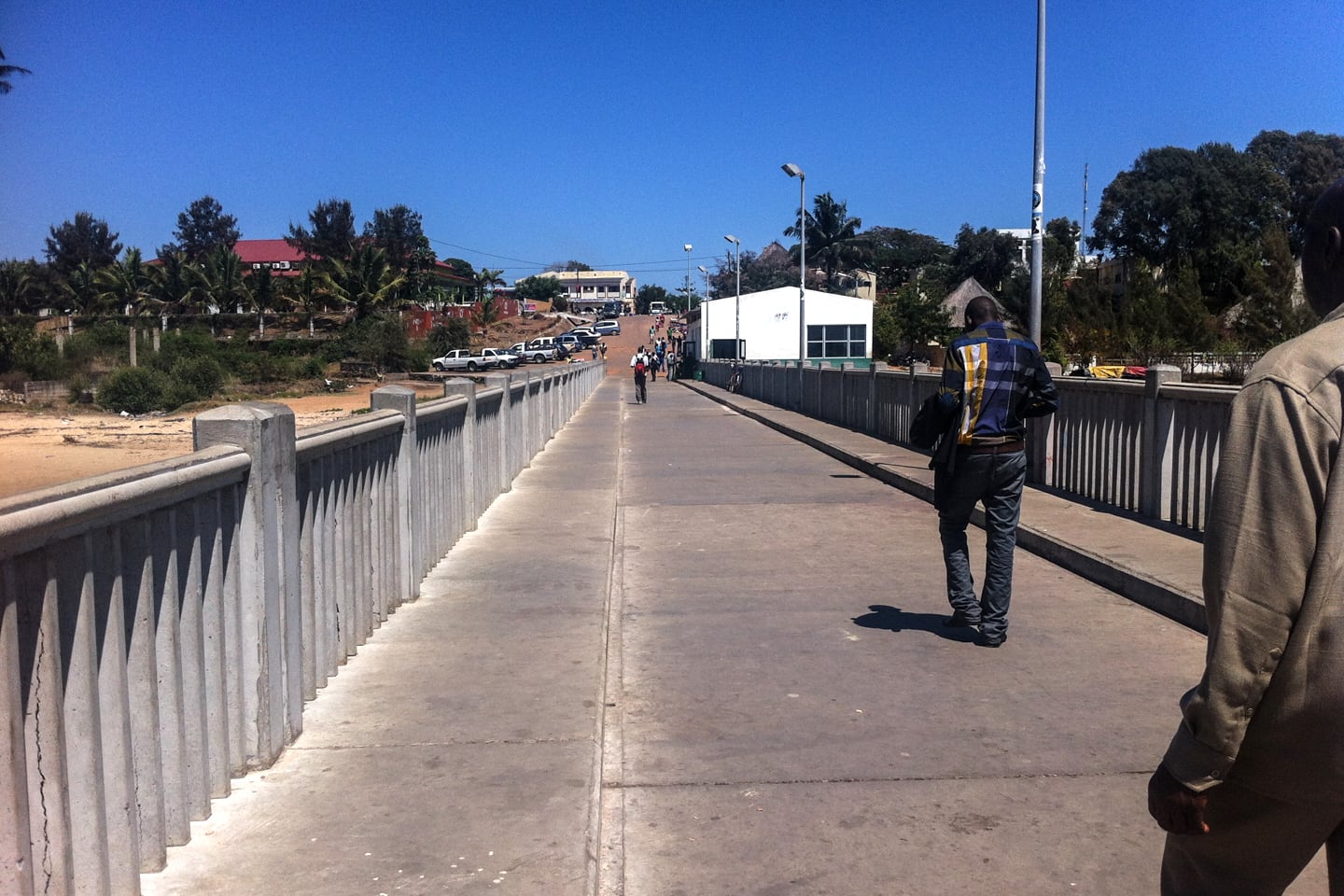
Big Boat, Little Boat
This post was a composite of a handful of trips we took to or through Maxixe over several days. We arrived on the Post Bus and bee-lined it to Inhambane, where we spent two nights before heading to Linga Linga (then back to Tofo, before leaving out of Maxixe for Beira). A bit convoluted, but the best way to accomplish what we wanted to without our heavy packs. One morning while staying in Inhambane, we took the ferry across the bay to show Lori around, get some capulanas, etc. With all this back and forth, we ended up riding the ferries quite a bit.
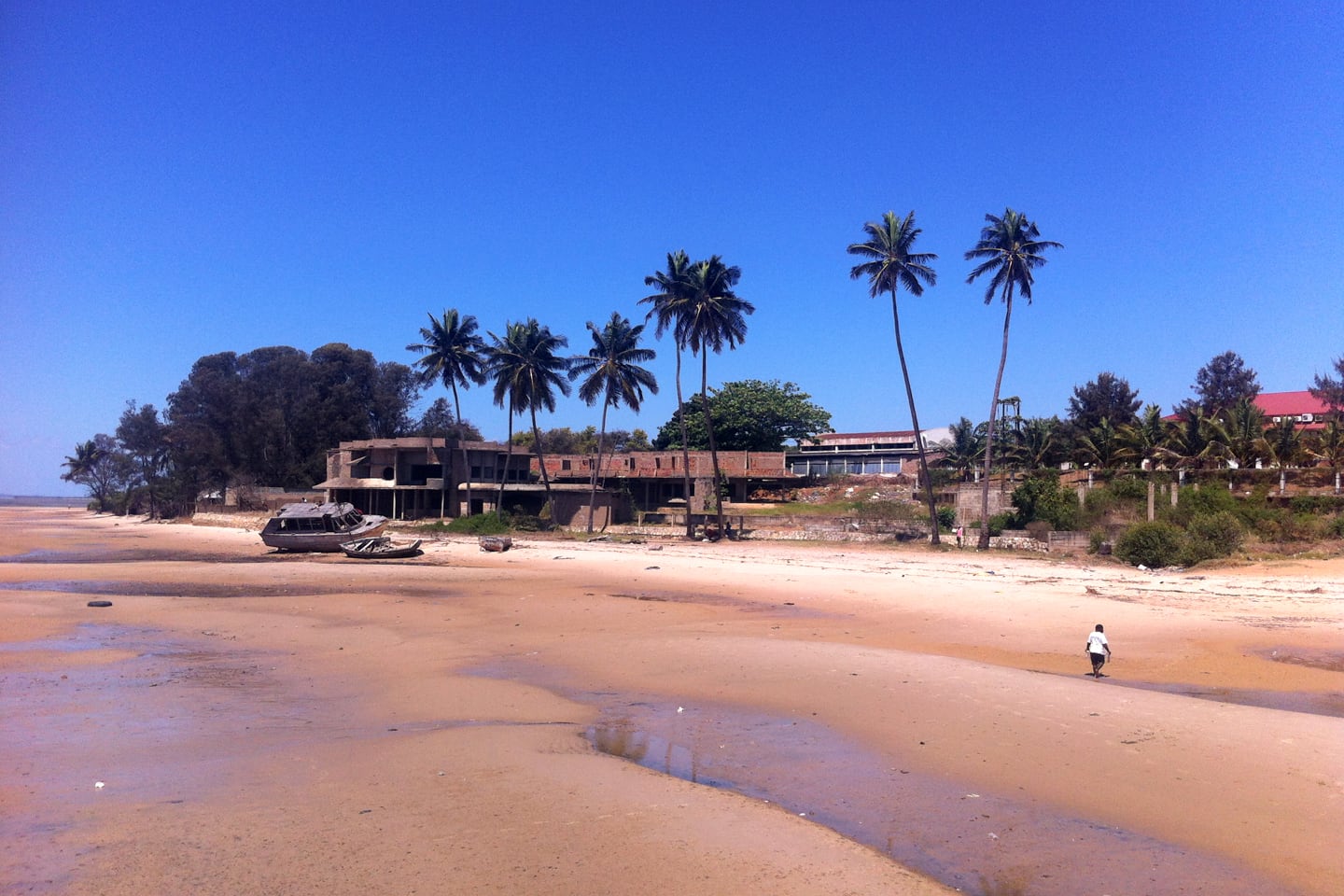
The Maxixe waterfront looks much of the same way it did in 2006, but for a new pier, complete with gangway and floating platform.
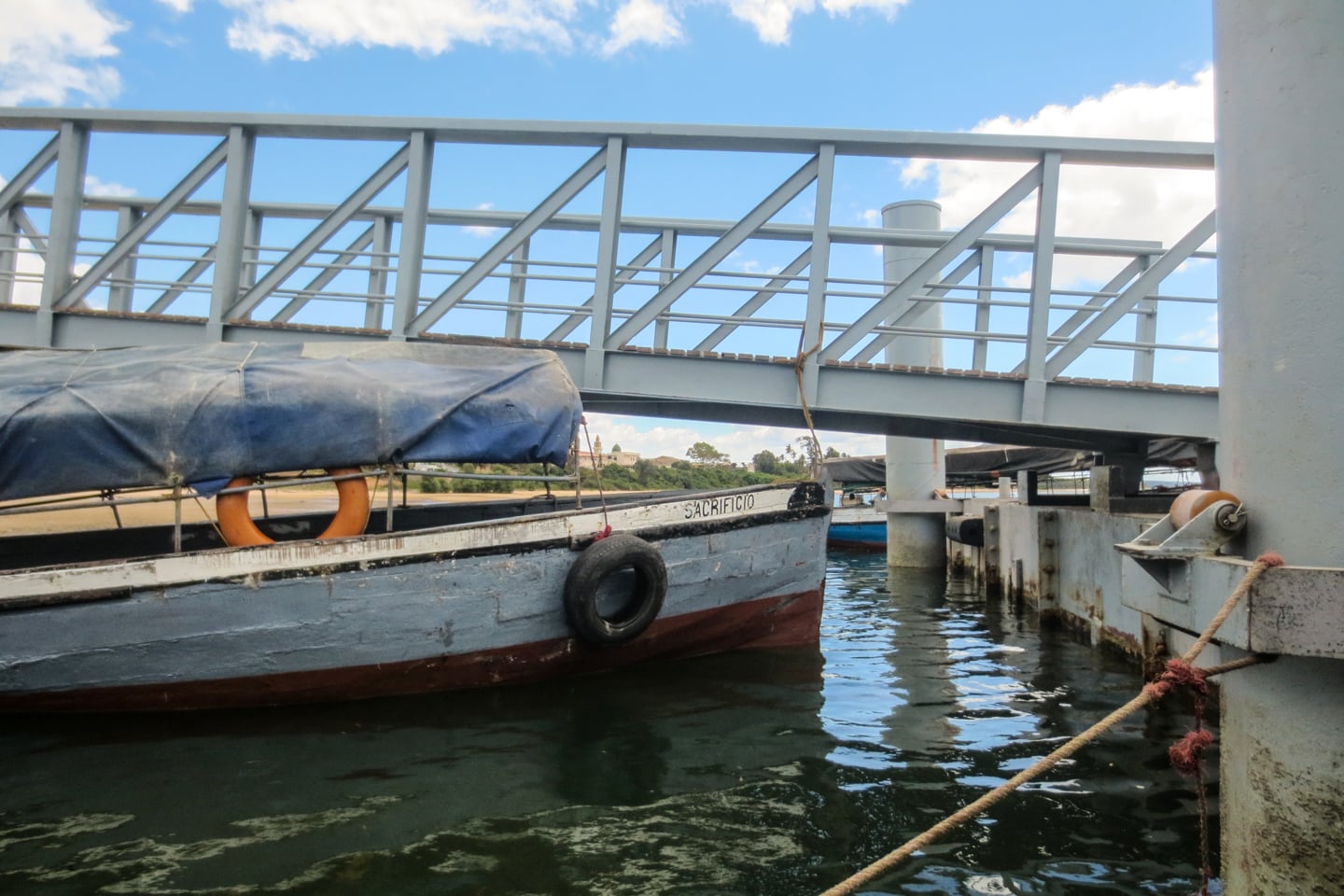
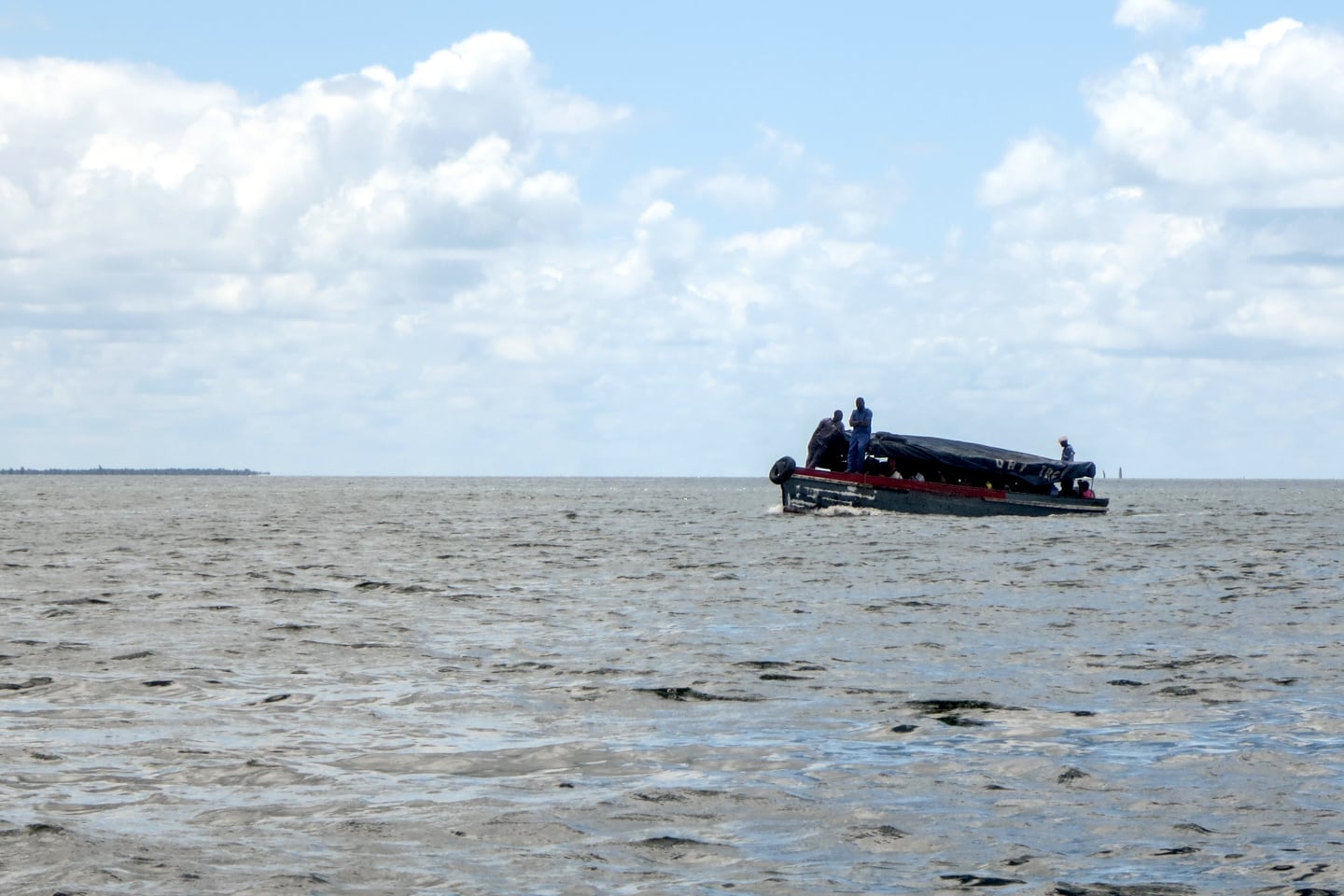
There are now two companies making regular runs across the bay: the old motorized dhows that I used to ride regularly (above) and big steel hand-me-down ferries from Greece (below). While the big ferries are infinitely more comfortable than the old dhows, the smaller of the two fill up much quicker (thus, less waiting). And, you really haven’t had the complete Maxixe/Inhambane experience until you’ve made the crossing in the classic motorized dhow. One of ours even ran aground on the sand bar, which brought back all sorts of warm and fuzzy memories.
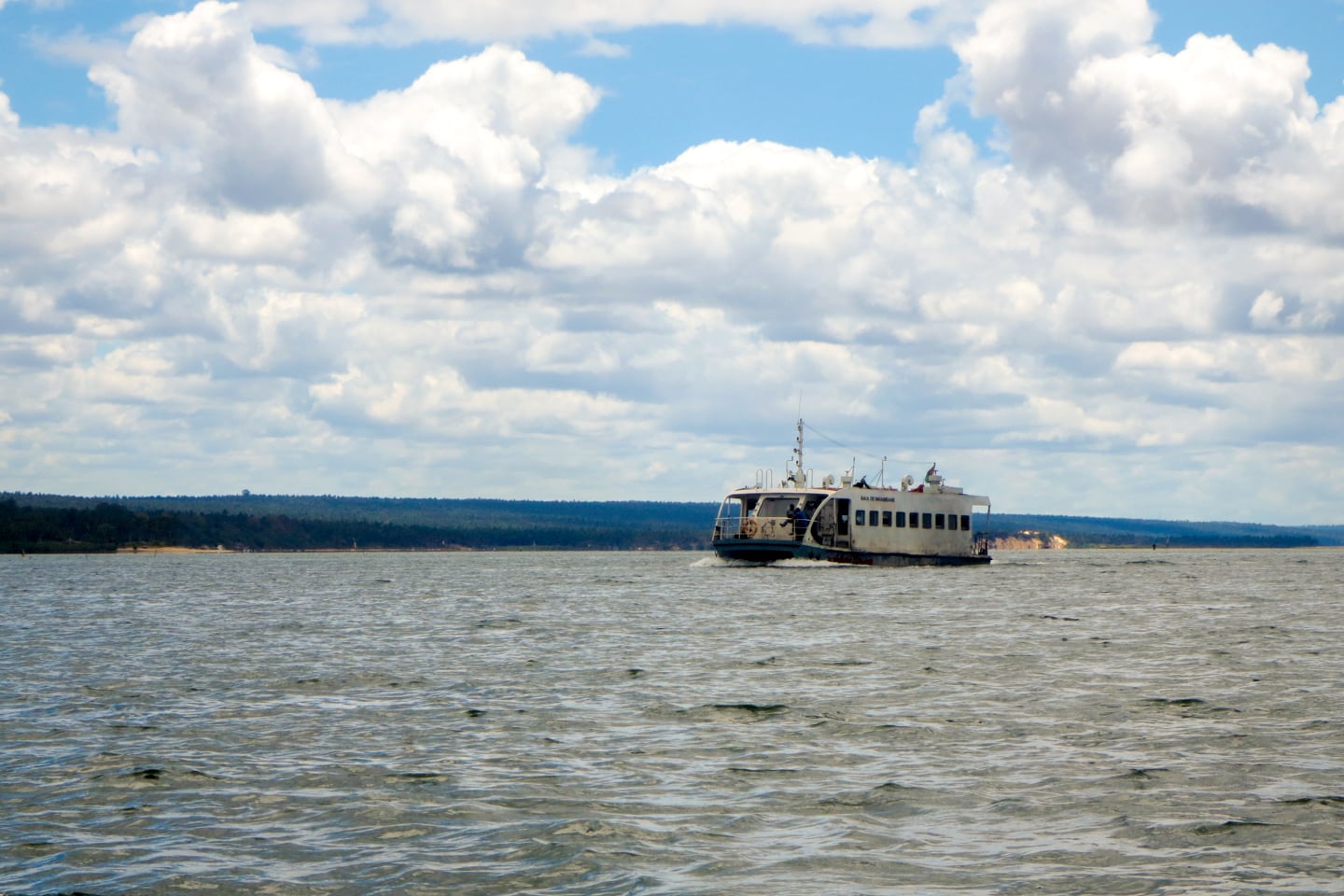
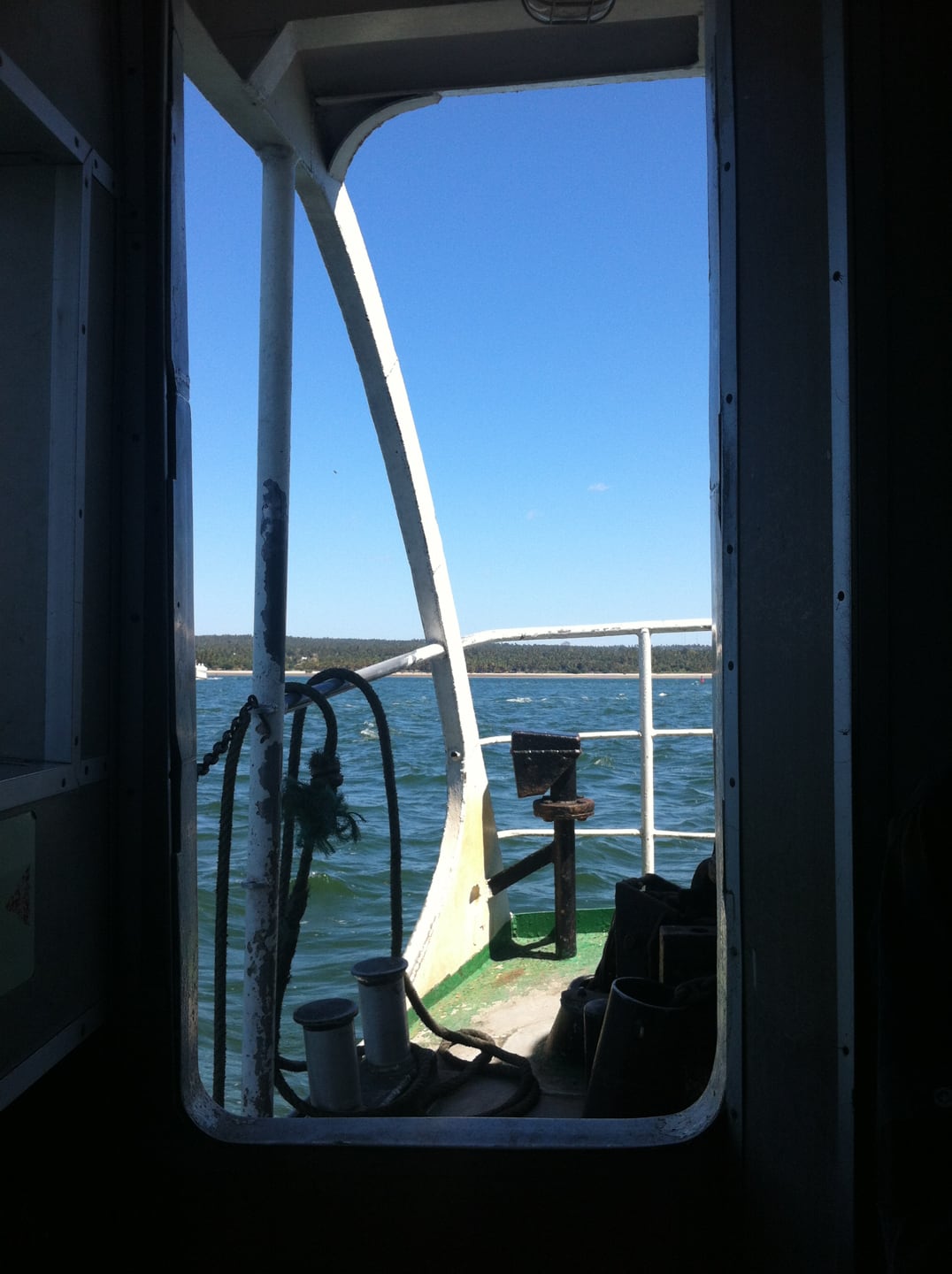
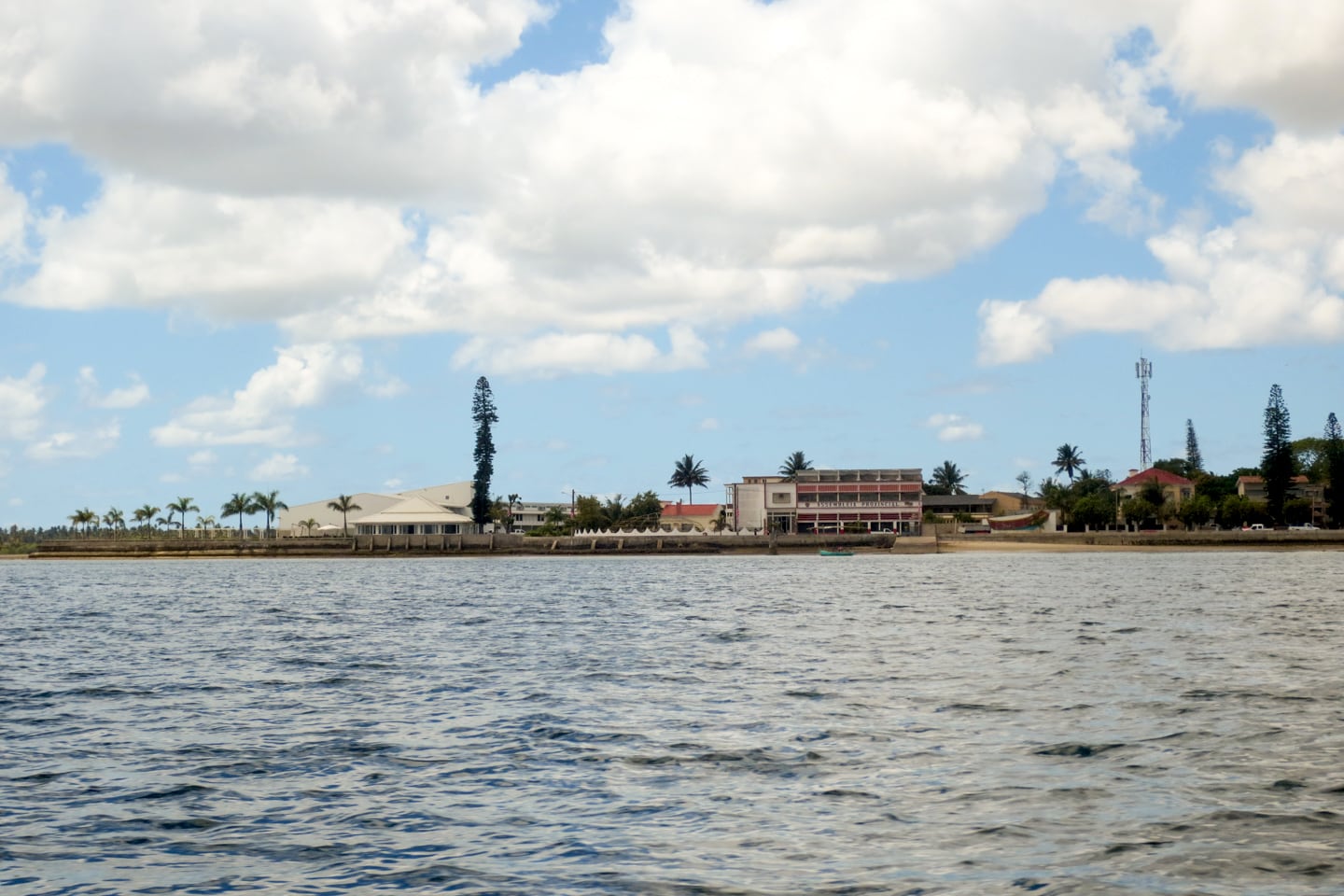
Crossing the bay for the first time in eight years gave me goosebumps. It helped that Inhambane City looked better than ever and it was a gorgeous day.
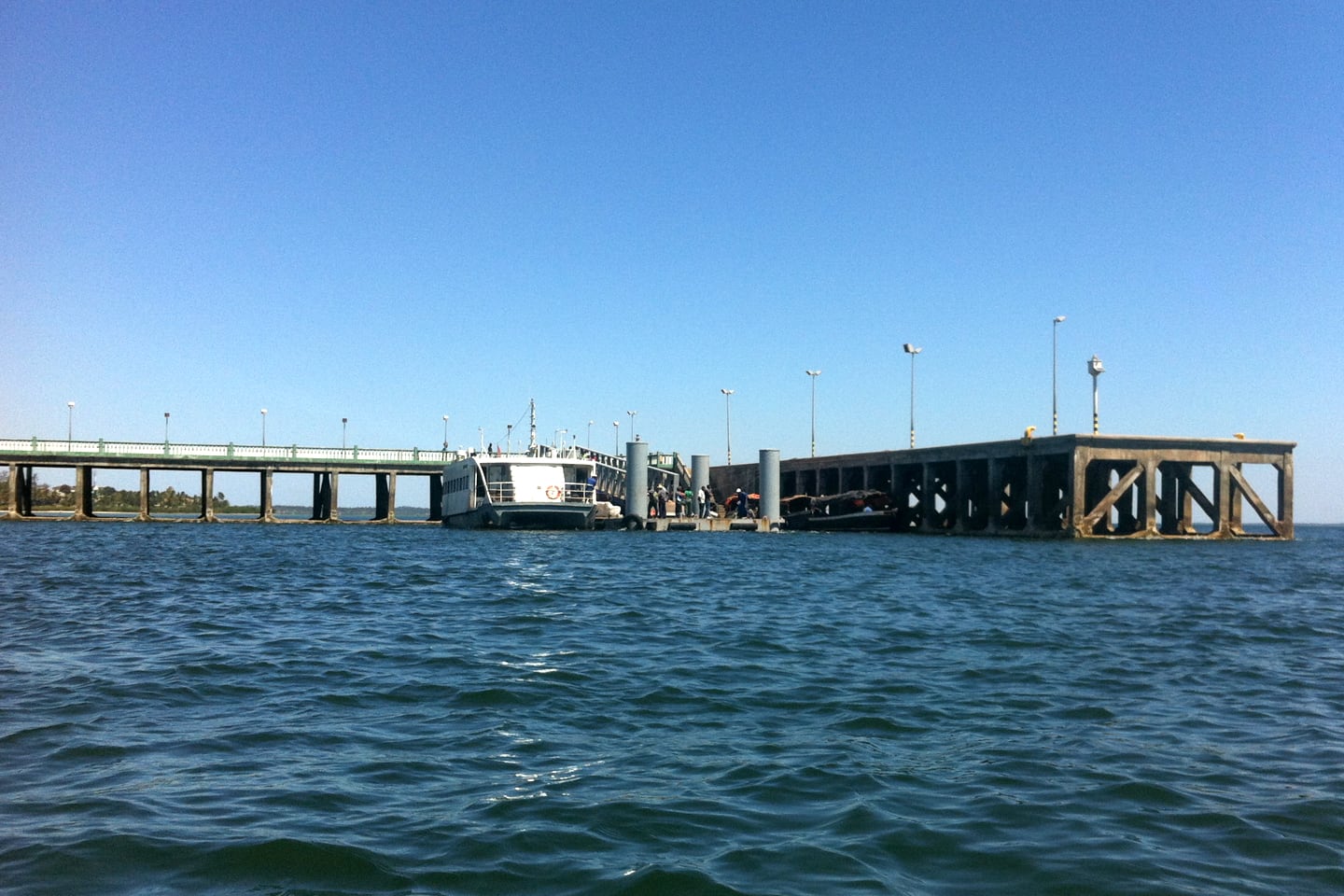
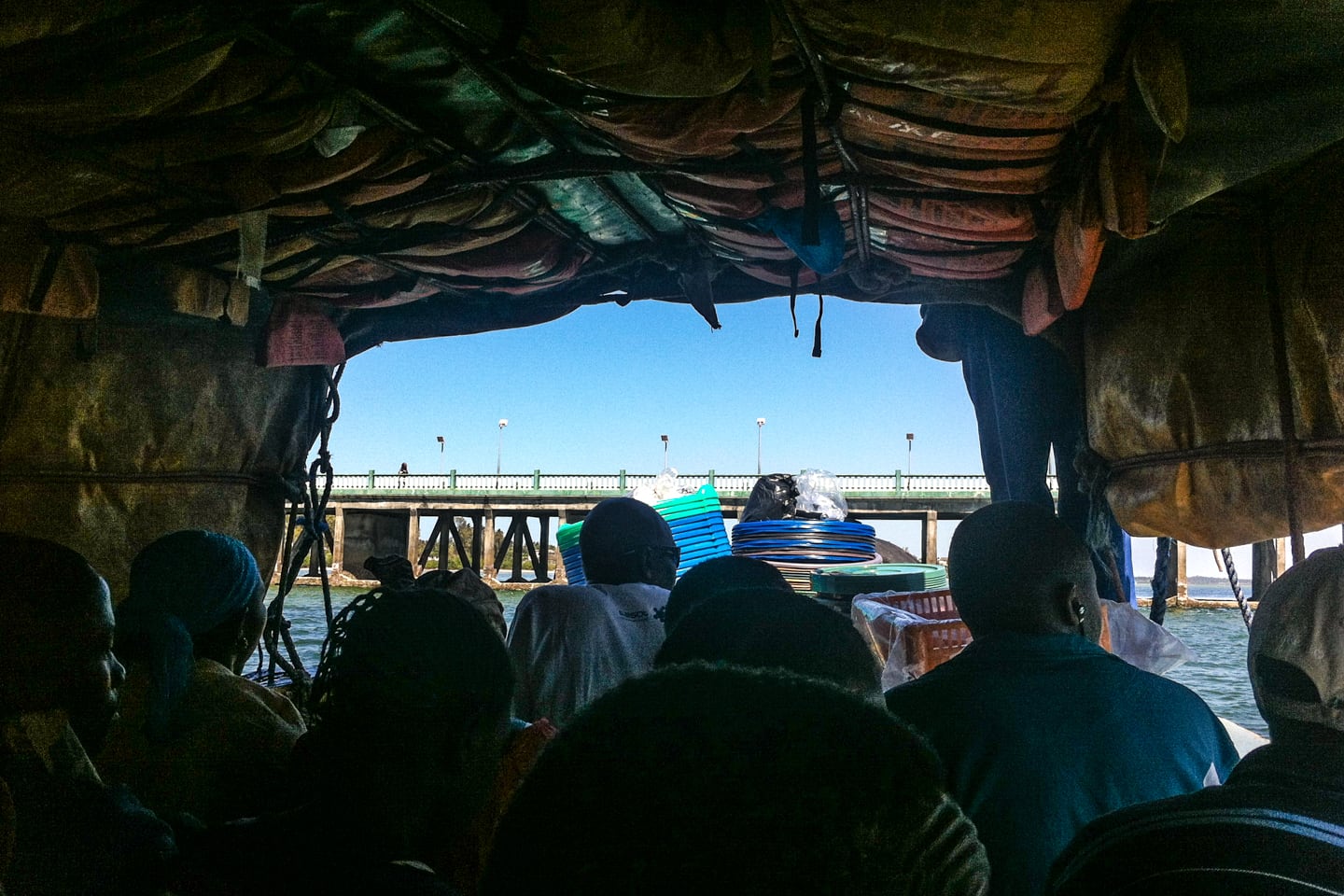
Approaching Inhambane City on one of the old motorized dhows and stepping onto the pier after a long time away. Very weird and yet eerily familiar. Stay tuned!
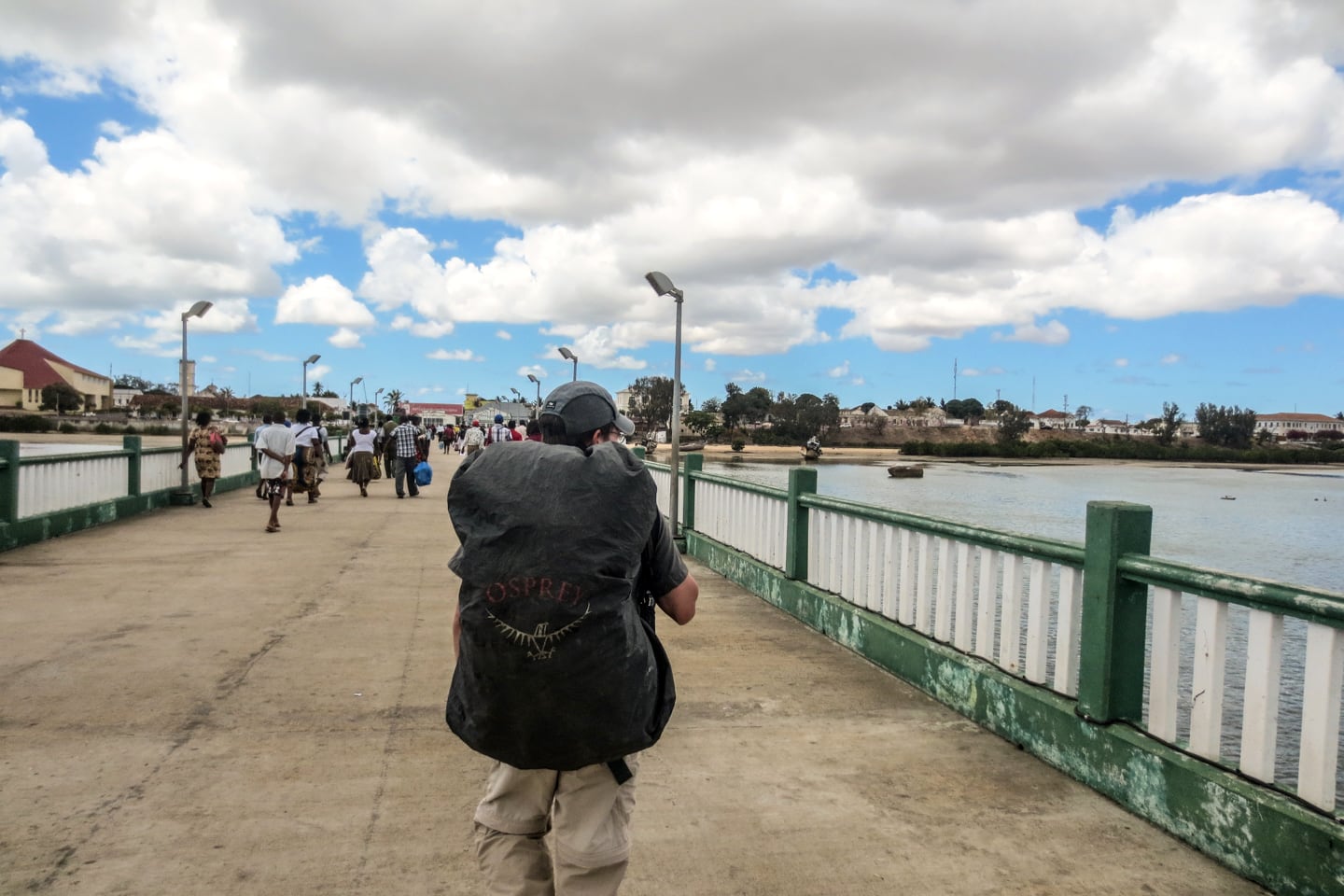
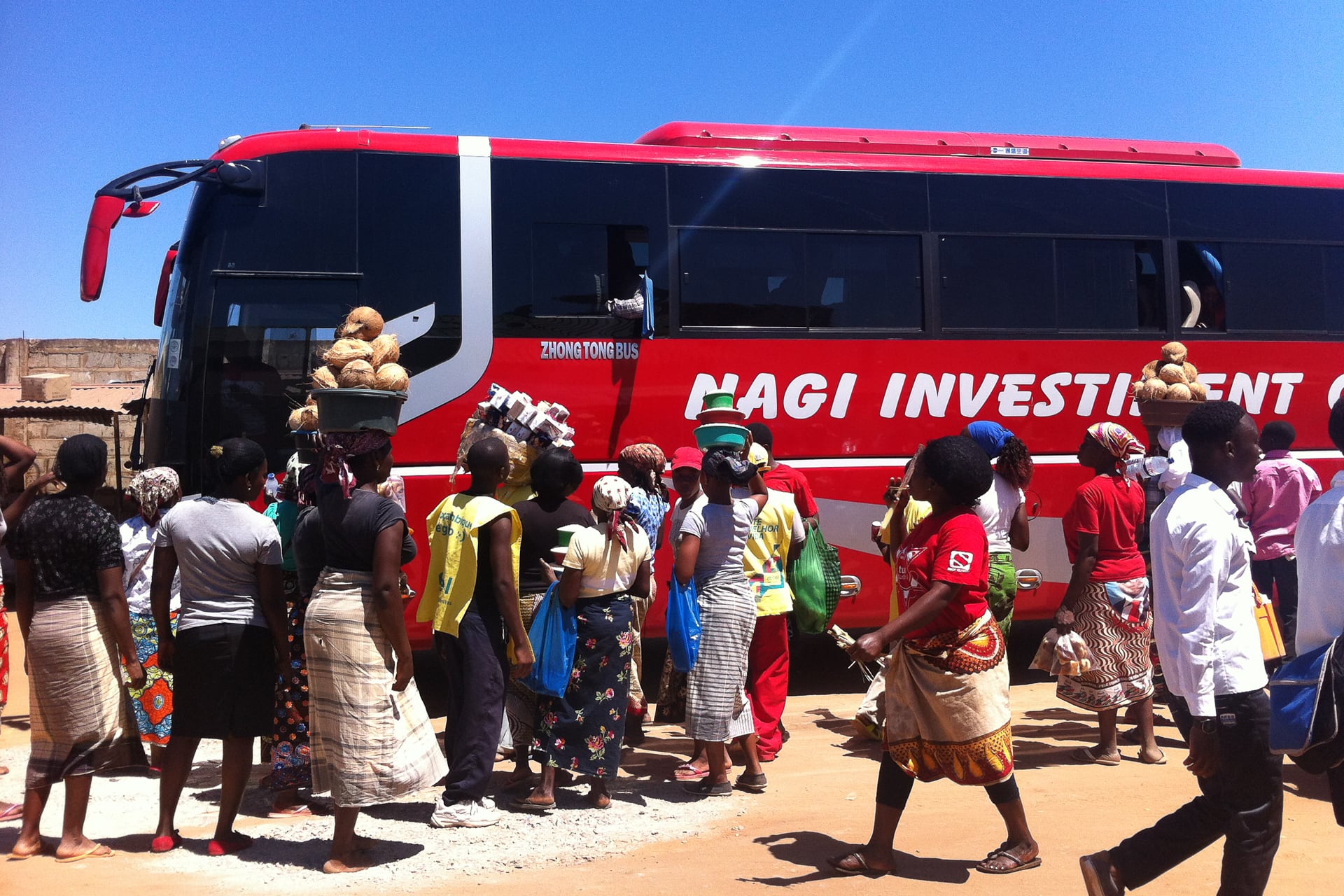
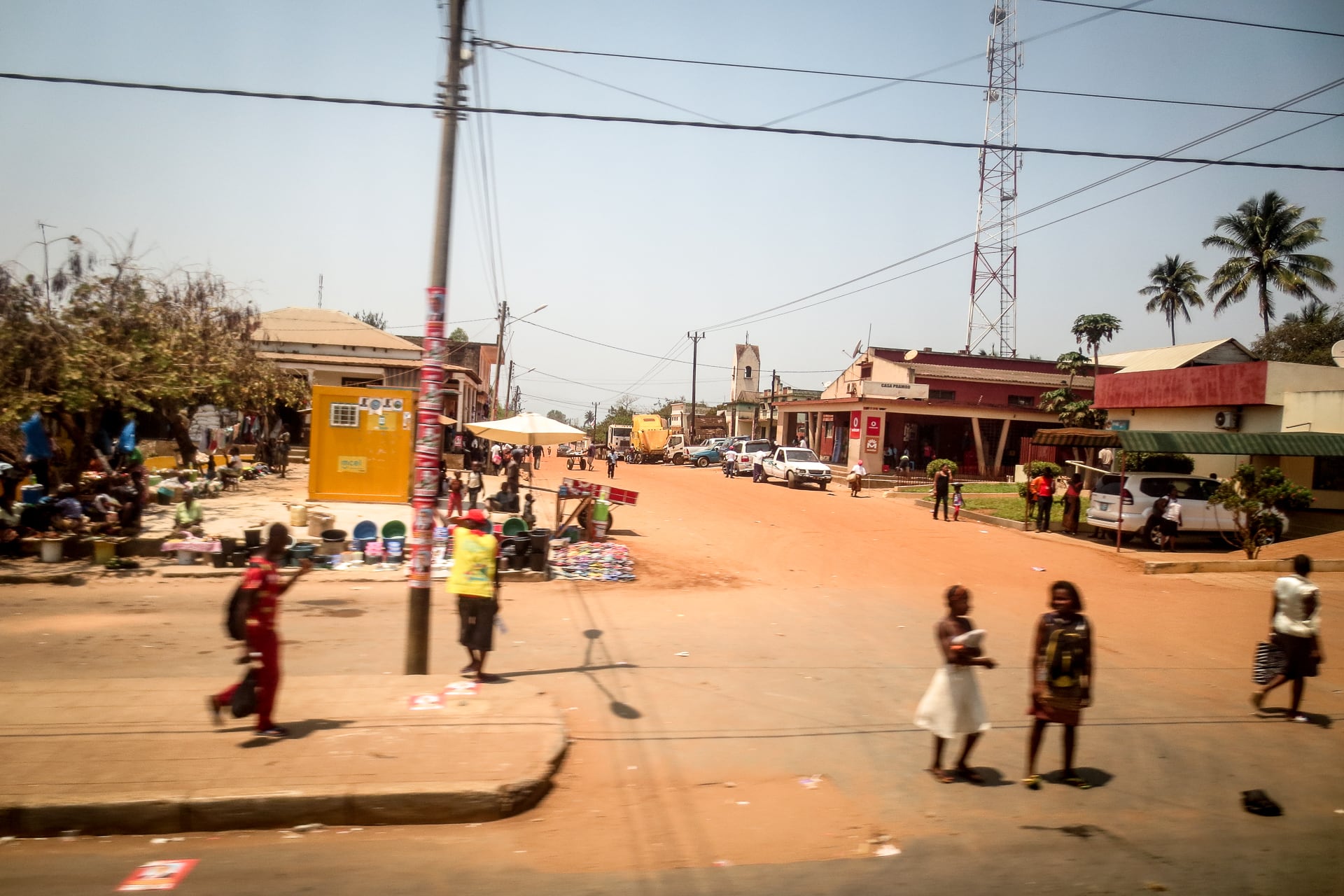
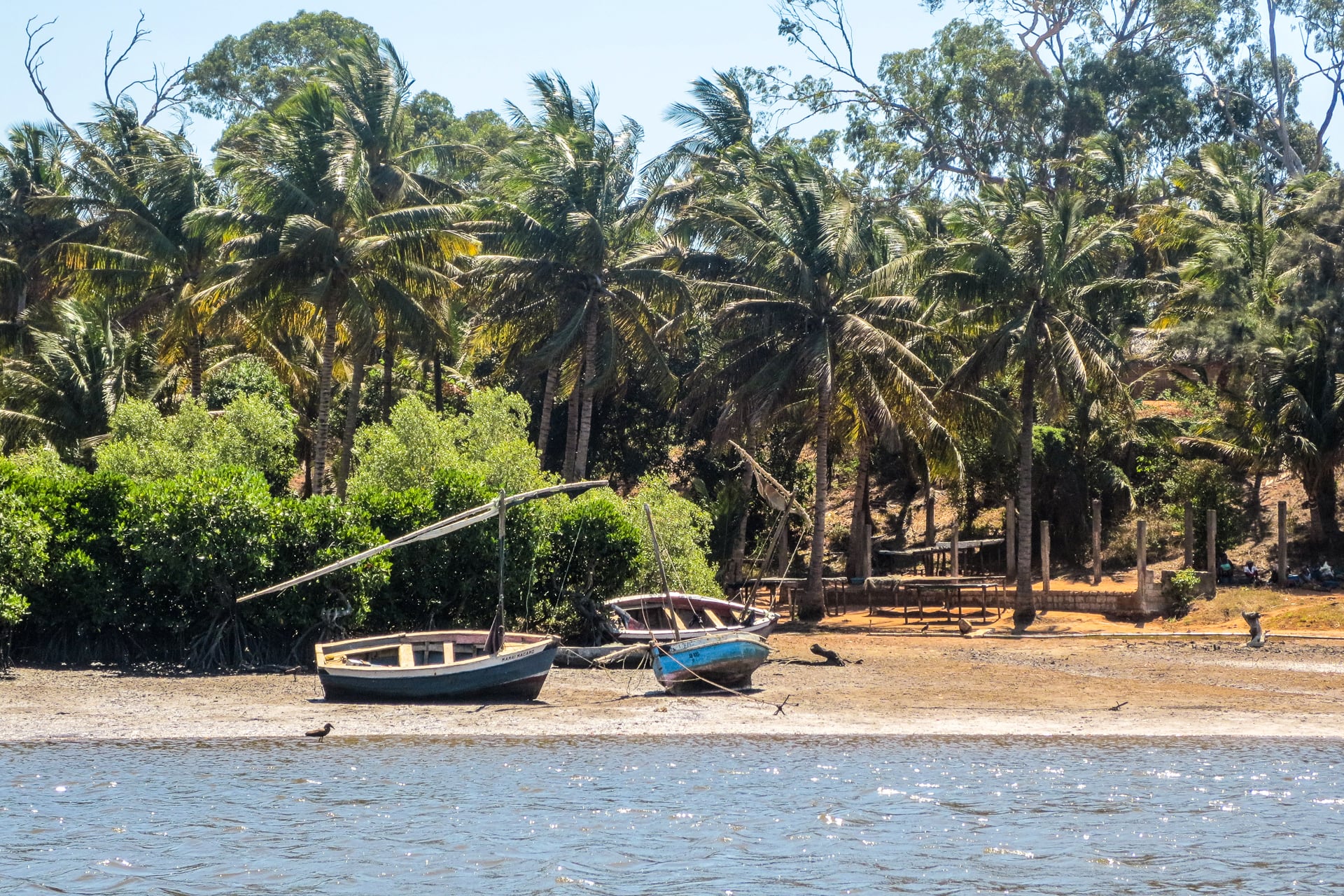
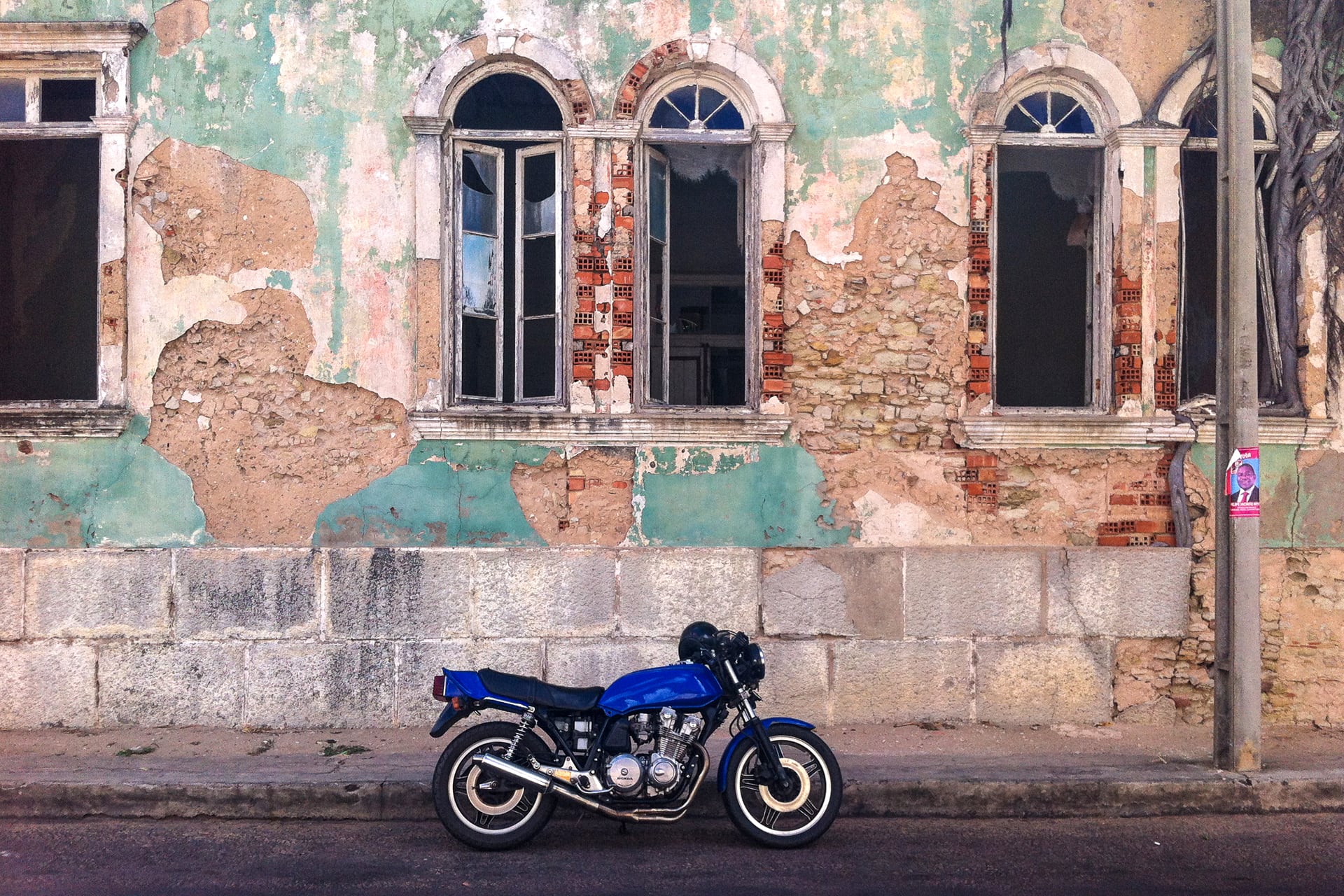
Fantastic, so informative.
Yes,things DO change,8years is a long time, but so do people, sometimes not for the better.
Happy you are safe! GM 🙂